
- How to – guides
- Skills List
- How to – guides
- North America
- South America

Work and Travel in Austria
Help us grow. share what you know about getting work in austria for travellers., volunteer and paid work opportunities in austria for travellers.
Austria is known for its beautiful cities, stunning landscapes, and Mozart. But if you want to do more than your conventional tourist, think about work and travel in Austria . Not only will you have the chance to dig deeper under the surface of the country, work in Austria will allow you to extend your trip for longer and gain some worthwhile experience. It’s not always easy to know where to turn for volunteer opportunities in Austria. However, our travel guide to Austria provides you with everything you need to plan your next trip. 1. Learn about Self-Sufficiency in Austria Outside of the cities, such as in Konigsdorf, the self-sufficiency movement has gained steam. From large country mansions to little farmsteads, Austrians are learning how to fend for themselves. Search for self-sufficiency projects in Austria. Anyone with DIY skills will be in high demand, as well as anyone who knows about gardening. But many projects will also offer you on the job training. 2. Teach English in Austria Many people visit Vienna, Salzburg, and Graz and automatically believe that everyone speaks fluent English. It’s true that the major cities have a high number of English speakers. However, despite Austria’s strong sense of social duty, there’s a real shortage of qualified English teachers in the smaller towns and villages. Do you have what it takes to teach English in Austria? Work in Austria doesn’t require you to know anything but basic German and you’ll be fully supported as you settle in. 3. Go to the Alps as a Ski Instructor Austria’s ski resorts are legendary. Imagine how valuable a season working in one of those ski resorts could be for you. Not only will you gain the perks of free access to some of the best ski slopes in Europe, but you’ll also be able to teach people about the sport. This is invaluable experience that will serve you well on any future job application. It’s one of the best options for work and travel in Austria. Just bear in mind that competition is fierce and you’ll be expected to apply months in advance of the main ski season.
VOLUNTEER WORK VISA / PERMIT REQUIREMENTS FOR AUSTRIA
Travel in Austria requires you to comply with the immigration requirements of the Schengen Zone . That means UK citizens, prior to Brexit, and citizens of other European Union (EU) countries are able to enter and work in Austria without any form of visa. You are able to stay for as long as you like. From outside the Schengen Zone, things start to differ. For example, South Koreans, the Japanese, Australians, Kiwis, and North Americans are required to get a Schengen visa-on-arrival and can only stay for a maximum of 90 days in every 180 days . With Austria being in the heart of EU, visa runs are not a viable option. Furthermore, overstaying your visa means you can be banned from the whole of the EU for many years. For South Africans, Russians, and Chinese citizens there’s no visa-free allowance. They have to apply for a formal Schengen visa prior to their arrival. For more info click here . These visas don’t apply to paid work. If you manage to land a paid job during your stay you will be expected to apply for a work visa. Depending on where you’re from, these can be notoriously difficult to secure.
SEASONAL BACKPACKER SKILLS NEEDED IN AUSTRIA
Spring work.
Spring marks the end of the ski season and the melting of the heavy snows that cover Austria. Many outdoor projects are active at this time of year. For example, you can join in with revitalisation projects that take place within the forests and woods of Austria. Many of these are also active around the Alps, towards the border with Slovenia. This is also a good time of year to be volunteering on a farm. Many farmers in Austria require a lot of help during the planting season.
SUMMER JOBS
Summer in Austria brings glorious sunshine and a whole host of tourists. This is an excellent time to visit the cities of Austria. You can teach English to children as part of a summer camp. It’s also possible to find work in general summer camps, where you will be keeping the kids entertained. Throughout the cities, hostels are crying out for volunteers to help them with the increased workload. The most popular location for this is Vienna, but you can also find a number of roles in Innsbruck, Graz, and Salzburg.
For the autumn season, you should refer back to the ‘Spring’ section for more information. Most of the specialist skills required are the same as the spring. Farm work is a popular option for work in Austria because it’s the harvest season. Farmers also need help preparing their farms and their animals for the winter. If you want to travel in Austria long-term, it’s also an ideal time to try to find teaching jobs with longer contracts in the rural areas.
Austria turns into a winter wonderland at the end of the year. It brings hundreds of thousands of people every year to the Alps. Alpine ski resorts are difficult to secure jobs in, but if you can get one you’ll have a great piece of experience to add to your CV. You can find roles in cleaning, customer service, and working directly on the slopes yourself. The best position for you depends on your previous experience. Ski resorts tend to fill positions months in advance of the ski season itself. Try to apply during the summer and autumn to increase your chances of finding a volunteer opportunity in an Austrian ski resort.
ATTITUDE TO FOREIGNERS WORKING OR VOLUNTEERING IN AUSTRIA
With recent political goings on, it’s easy to think that Austria is less welcoming than it once was. If you travel in Austria today you’ll notice that the media has exaggerated how the country reacts to foreigners. You won’t have any issues fitting into Austrian society during your time here. Austrians are used to foreign visitors and you don’t need to worry about any hostility. Just make sure you’re not breaking the rules of your visa when you take up volunteering opportunities in Austria. Are you ready to take on work in Austria?
Recent Contributors
- Edited on May 18 2021 by
- Edited on Jun 11 2019 by
- Edited on Sep 20 2018 by
If you have worked in Austria or live here. Instead of saying `That information is not right` Please sign up to Working Traveller by clicking here and update this page with your opinions on the subject and your views on what the barter points should be. If your a host, you will have a SEO link added to the page directly to your own web site so viewers can see who provided the information. If you are a traveller it will link to your profile.

- Klagenfurt am Woerthersee
- Sankt Polten
- Niederoesterreich
- Oberoesterreich
WORKING TRAVELLER LTD 27, Lonsdale Rd, Blackpool, FY1 6EE, UNITED KINGDOM
Work and travel the world using your skills to gain work experience and references for a good job back home
Log in with your credentials, forgot your details.
0 Suchergebnisse

Work and Travel
Verbinde atemberaubende reisen mit sinnvoller arbeit.
Einmal Traumland kreuz und quer . Unterwegs mit dem Rucksack , dann arbeiten , wenn es sich ergibt. Anderes lernen, anderes denken. Dich selbst entdecken .
Es gibt viele Möglichkeiten, ins Ausland zu gehen. Work and Travel ist perfekt für dich, wenn du flexibel und selbstständig reisen möchtest. Wir helfen dir gerne dabei, geben Starthilfe und sind in Notfällen für dich da. Reise durch dein Traumland, finanziere dir deinen Aufenthalt durch Gelegenheitsjobs und lerne die Menschen und ihre Kultur kennen, gänzlich abseits der gängigen Touristenpfade.
- Gruppenflüge
Planung und Vorbereitung
Kombinationsmöglichkeiten.
- Länderauswahl
Darum mit AIFS
Voraussetzungen, wohin soll es gehen 🗺️.
Verreise allein oder mit Freundinnen und Freunden und einer AIFS Gruppe abenteuerlustiger Urlaubenden. Wir bringen euch zusammen und sorgen dafür, dass euer Abenteuerurlaub zu einem unvergesslichen Erlebnis wird.
Du weißt schon wohin es gehen soll? Worauf wartest du dann noch?
Wähle hier dein Ziel aus:
/aifs-australien-meer-person-felsen-quadratisch-header-800x800.jpg?width=800&height=800&name=aifs-australien-meer-person-felsen-quadratisch-header-800x800.jpg)
- langjährige Erfahrung als eine der größten und ältesten Organisationen, deren Gewinne über die gemeinnützigen Stiftung Cyril Taylor Charitable Foundation (CTCF) ausschließlich wohltätigen Zwecken zu Gute kommen
- Starthilfe bei der Planung und Reisevorbereitung
- Unterstützung bei allen Fragen durch Länderspezialisten
- Hilfestellung bei Visa-Beantragung
- Organisation der ersten Tage im Land
- Unterstützung bei der Jobsuche
- Ansprechpartner vor Ort und Hilfe im Notfall
- Specials, wenn du mit Freunden reisen möchtest
- Kombinationen (inkl. Rabatt!) mit Sprachkurs, Surfcamp, Farmwork oder einer Freiwilligenarbeit - vieles ist möglich
Um mit uns Work and Traveln zu können, solltest du folgende Voraussetzungen mit „Ja“ beantworten können:
Du bist mindestens 18 Jahre alt?
Familienstand
Du bist unverheiratet und kinderlos?
Du beantragst zum ersten Mal das Working Holiday Visum ?
Finanzielle Rücklagen
Du bist finanziell für die Zeit deines Aufenthaltes abgesichert? (finanzieller Nachweis bei Visumsbeantragung in Höhe von ca. 2.500 Euro)
Sprachkenntnisse
Du kannst dich gut auf Englisch verständigen? Die Kommunikation vor Ort erfolgt auf Englisch.
Staatsbürgerschaft
Du besitzt die österreichische oder deutsche Staatsbürgerschaft ? Hast du eine andere Nationalität, kontaktiere uns bitte.
Du besitzt bei Einreise einen noch ausreichend gültigen österreichischen oder deutschen Reisepass ? Hast du eine andere Nationalität, kontaktiere uns bitte.
Versicherung
Du kannst einen ausreichenden Auslandskrankenversicherungsschutz nachweisen? ( auch über uns buchbar )
Gesundheit & Impfschutz
Erfreust du dich guter Gesundheit und bist gegen alles Notwendige geimpft ?
Über notwendige sowie empfehlenswerte Impfungen und medizinische Vorkehrungen kannst du dich auf der Website des Bundeministeriums für Europäische und Internationale Angelegenheiten informieren. Es ist dringend empfehlenswert, frühzeitig vor Reisebeginn reisemedizinische Beratung bei einem Facharzt einzuholen.
Schweizer Staatsbürger informieren sich auf der Seite des Eidgenössischen Departements für auswärtige Angelegenheiten und Deutsche Staatbürger auf der Webseite des Auswärtigen Amts sowie auf der Website des Centrums für Reisemedizin .
Eingeschränkte Mobilität
Das Abenteuer ruft! So kommst du in 4 Schritten zu deinem Work and Travel Abenteuer
1. Informiere dich
2. melde dich an, 4. los geht's, eindrücke 📸.

Du kannst Work and Travel alleine oder in Kombination mit einem anderen AIFS Programm buchen. Fast alles ist möglich.
So hast du nach deinem Programm noch die Möglichkeit andere Facetten deines Reiseziels zu entdecken.
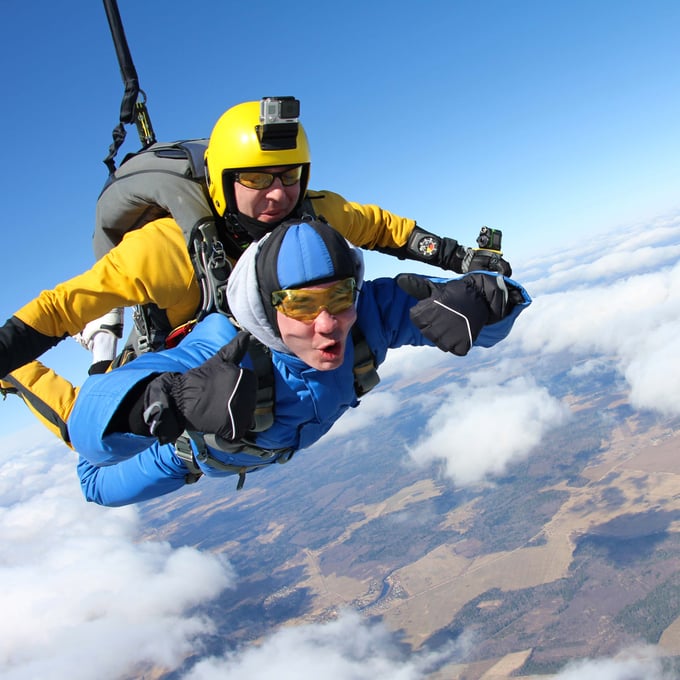
Adventure Trips
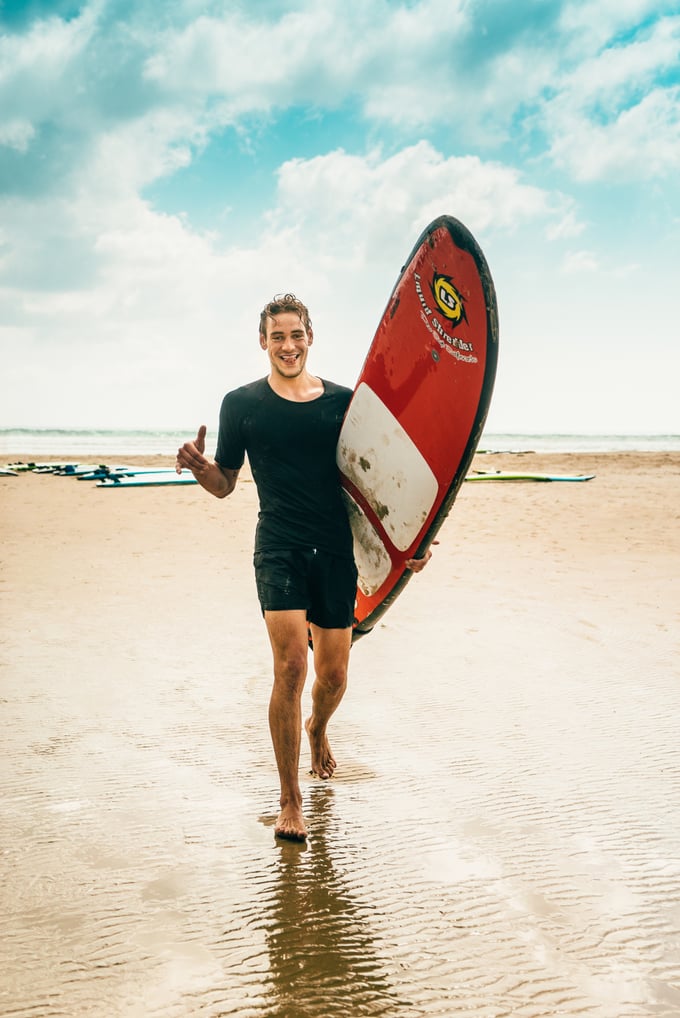
Auslandspraktikum
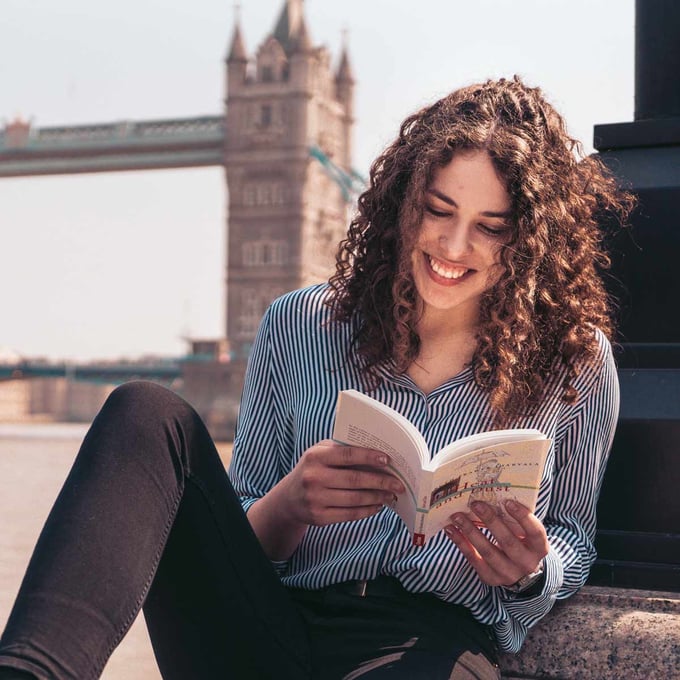
Sprachreise

Freiwilligenarbeit
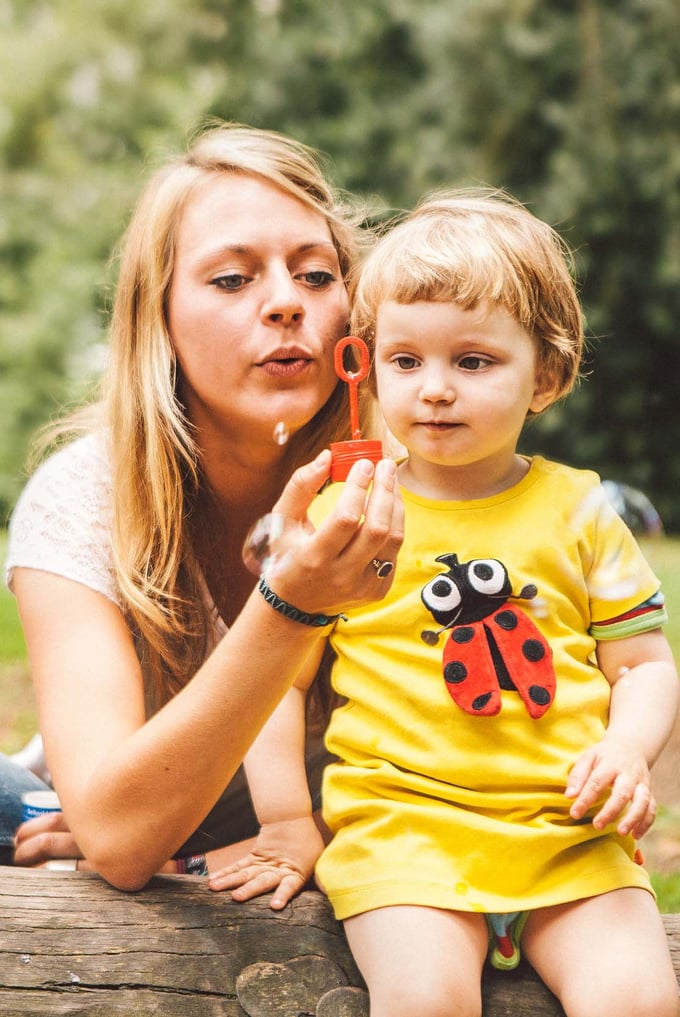
Studieren im Ausland
Das könnte dich auch interessieren.
Ein Work and Travel Aufenthalt ermöglicht es dir bis zu einem Jahr lang in einem Land zu leben, zu arbeiten und es zu bereisen. Hilfreiche Tipps für dein Auslandsabenteuer findest du in unserem Blog.

Work and Travel Jobs – Arbeiten im Ausland

Freunde im Ausland finden – unsere Tipps

Koffer packen für 1 Jahr im Ausland – was gehört auf deine Packliste?
Auf unseren zahlreichen Events hast du die Möglichkeit deine Fragen persönlich mit uns zu klären und dich zu informieren.
JuBi Frankfurt
15. Juni 2024 / 10:00 Uhr
Auslandsaufenthalte während der Schulzeit - Schüleraustausch
17. Juni 2024 / 19:15 Uhr
vocatium Bielefeld 2024
18. Juni 2024 / 08:30 Uhr
Work and Travel, Freiwilligenarbeit, Sprachreisen, Adventure Trips und mehr!
18. Juni 2024 / 17:00 Uhr
Häufige Fragen 🤔
Wir haben diesbezüglich unterschiedliche Erfahrungen gemacht – meist ist es jedoch so, dass das Kindergeld für die Dauer des Aufenthalts nicht weiter gezahlt wird.
Bitte erkundige dich bei deiner Kindergeldstelle. Wir stellen dir zusammen mit deiner Rechnung eine Teilnahmebestätigung aus. Diese kannst du bei der Kindergeldstelle einreichen.
Wer flexibel und aufgeschlossen ist und sich bei den Bewerbungen engagiert, erhält auch ein Angebot.
Da die Working Holiday Visa schon seit mehr als 10 Jahren vergeben werden, hat sich der Arbeitsmarkt an diese Gelegenheitsjobber gewöhnt. Farmen und Ranches sind auf die Kurzzeitarbeiter besonders angewiesen, sodass in diesem Bereich die meisten Jobs zu finden sind.
Natürlich solltest du dennoch finanziell abgesichert sein für den Fall, dass es einmal länger dauert bis du einen Job findest. Lass es also am besten nicht so weit kommen, dass du absolut kein Geld mehr auf dem Konto hast, bevor du dich um einen Job kümmerst.
Du hast auch die Möglichkeit sogenannte WWOOF-Jobs zu machen, bei welchen du auf einer Farm oder Ranch gegen Kost und Logis arbeitest. Du verdienst dort zwar kein Geld, hast aber auch keinerlei Ausgaben, da du komplett verpflegt wirst. WWOOF ist eine tolle Alternative, um die Zeit zwischen beispielsweise zwei bezahlten Jobs oder dem Reisen und einem bezahlten Job zu überbrücken.
Du hast ganz verschiedene Möglichkeiten eine Unterkunft zu finden. Ob du es bevorzugst während deiner Zeit im Ausland in verschiedenen Hostels unterzukommen oder ob du lieber in eine WG ziehst oder campst, ist vollkommen dir überlassen. Oft ist es auch so, dass du bei deinem jeweiligen Arbeitgeber wohnen kannst. Manchmal fällt eine geringe Miete pro Woche an, welche dir direkt von deinem Lohn abgezogen wird.
Alle Zielländer sind bekannte Backpackerdestinationen, die auf die Ankunft vieler Reisenden eingestellt sind. Du solltest natürlich besonders an Wochenenden oder wenn Veranstaltungen in der Stadt anstehen, früh genug ein Zimmer bzw. einen Campingplatz reservieren.
Du kannst alle unsere Programme auch zusammen mit einem oder mehreren Reisepartnern machen. Am besten du gibst direkt bei deiner Anmeldung zum Programm an, dass du einen Reisepartner hast, dann können wir euch direkt einander zuordnen.
Wenn du und dein Reisepartner euch am selben Tag zum selben Programm anmeldet, erhaltet ihr sogar jeweils einen Reisepartnerrabatt in Höhe von 25€. Solltest du sogar mehr als einen Reisepartner haben, hast du die Möglichkeit einen Rabatt von bis zu 100€ zu bekommen.
Ein Work and Travel Aufenthalt ist definitiv auch ohne Arbeitserfahrung problemlos möglich. Gute englische Sprachkenntnisse sowie persönliches Engagement helfen dir bei der Jobsuche weiter!
Das Work and Travel Programm bietet dir die Möglichkeit, einmal in völlig neuen Berufsfeldern praktische Erfahrungen zu sammeln und auch Arbeiten auszuüben, die du Zuhause nicht machen würdest.
Du hast noch weitere Fragen?
AIFS sorgt für einen reibungslosen Ablauf, angefangen bei der Kontaktaufnahme. Wenn du Fragen rund ums Work and Travel hast, melde dich gerne.
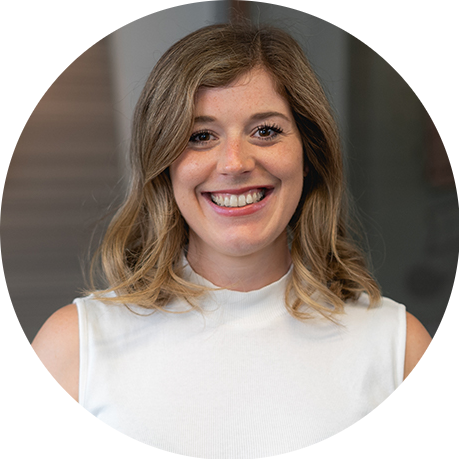
Julia von AIFS
- Nachricht senden
Nachricht an AIFS senden
Download aifs magazin.
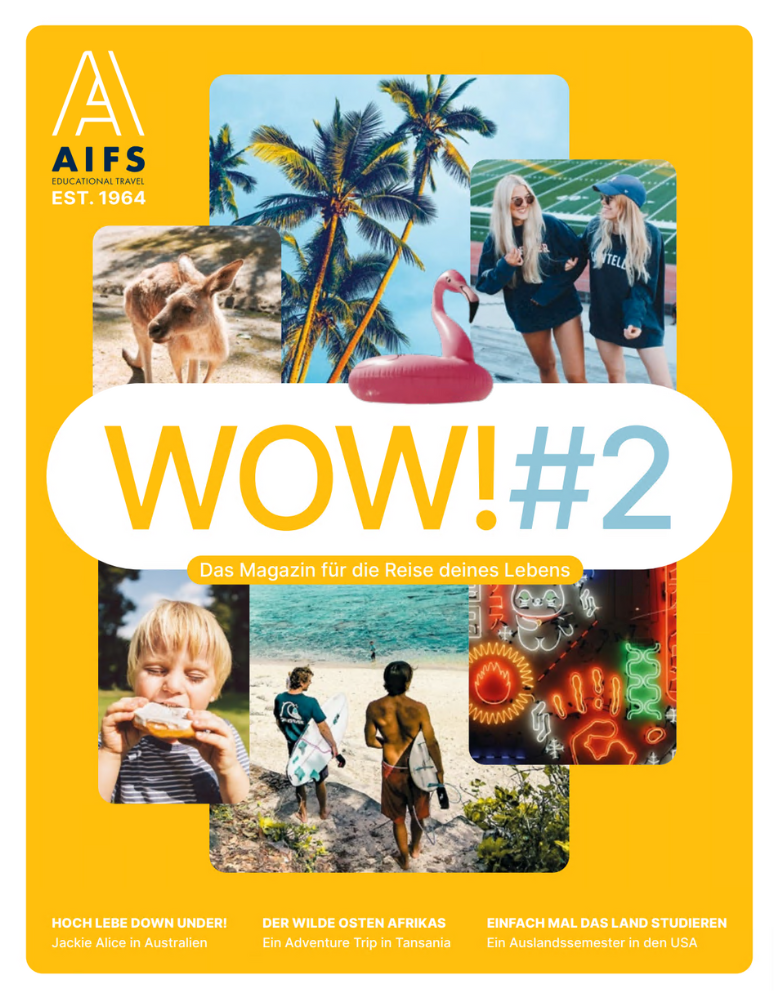
WOW! Das Magazin für dein Auslandsabenteuer
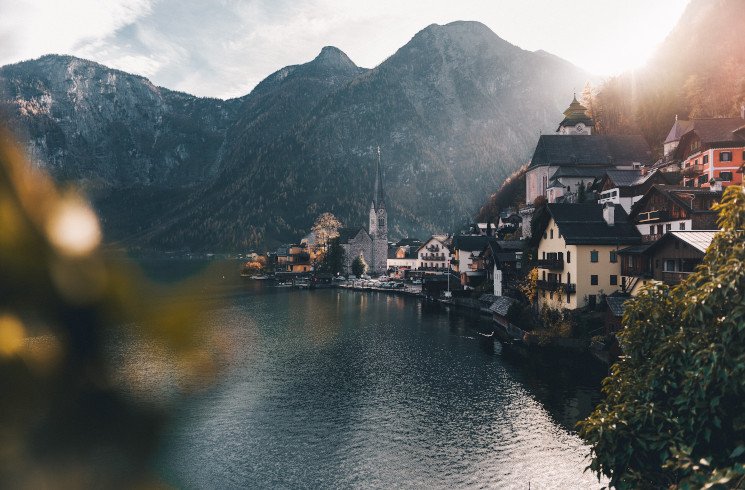
Work and Travel in Österreich
Österreich quick-info.
Wenn du als EU-Bürger in Österreich arbeiten möchtest, stehen dir beim Work and Travel in Österreich zahlreiche Möglichkeite n offen. Auch wenn Österreich nicht als klassisches Land für Work and Travel gilt, so gibt es hier dennoch tolle Jobs gerade auch im Bereich von Aushilfe, Praktikum und kurzfristiger Saisonanstellung. Besonderer Vorteil: ein Visum ist für EU-Bürger nicht erforderlich. Für Deutsche fällt außerdem die Sprachbarriere weg. Anders als in Deutschland bestehen in Österreich selbst übrigens keine Abkommen über Working-Holiday-Visa (WHV) mit anderen Staaten wie zum Beispiel Australien und Neuseeland. Für die Einwohner Österreichs bedeutet das mehr Aufwand bei der Organisation ihrer Work and Travel Aufenthalte auf anderen Kontinenten.
- Warum ist Österreich perfekt für Work & Travel?
Die wichtigsten Planungsschritte
- Erfahrungsberichte
- Arbeiten & Jobsuche in Österreich
Job-Angebote in Österreich

Warum Österreich perfekt für Work & Travel ist
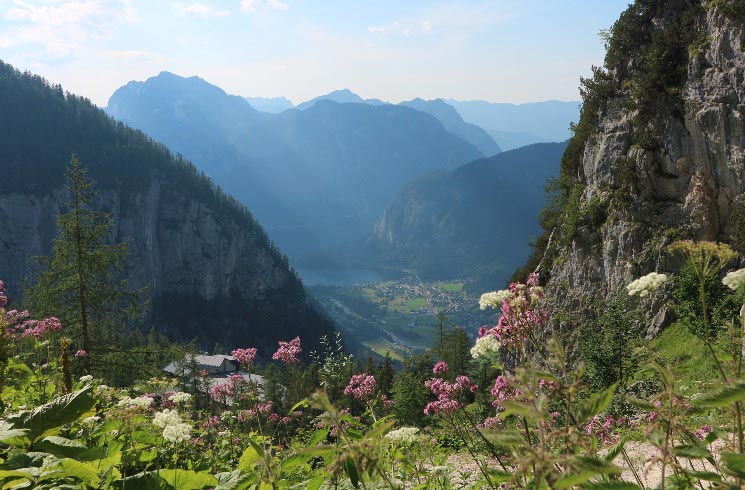
Mach dir keine Sorgen und hol dir zusätzliche Unterstützung bei deiner Planung
Die orga-app, e-mail tutorial, work & travel erfahrungsberichte aus europa.
Über die letzten Jahre waren wir immer wieder mit Bloggern, Vloggern und vielen Work and Travellern in Kontakt und haben diese nach ihren Eindrücken und Erlebnissen gefragt. Die beeindruckenden und inspirierenden Erfahrungsberichte aus verschiedenen europäischen Ländern findest du im Anschluss.
Unsere Top-Tipps für Jobsuche und Arbeiten
Die tourismus-branche erwartet dich.
Die Tourismus-Branche bietet dir in Österreich zahlreiche Möglichkeiten Work and Travel durchzuführen. Als Skilehrer kannst du die Touristen auf der Piste begleiten oder unterstützt die Hotels und die Gastronomiebetriebe bei der Unterbringung oder Verpflegung der vielen Gäste – besonders in der Wintersaison. Des weiteren hast du auch in Österreich die Möglichkeit ein Praktikum durchzuführen.
Jobs für Winterfans
Die Alpen als Skiregion haben besondere Formen des Work and Travel in Österreich hervor gebracht: So gibt es hier zum Beispiel Arbeitsgelegenheiten als Skilehrer oder Snowboardlehrer durchaus auch nur für eine einzelne Saison. Solche Angebote richten sich an EU-Bürger ab 18 Jahren und setzen Erfahrung beim Skifahren und Snowboarden voraus. Bevor dein Einsatz als Skilehrer in einer Skischule losgeht, absolvierst du eine entsprechende Ausbildung vor Ort.
>> Winterjobs in Österreich
>> Ski-& Winterjobs in Chile
Saisonanstellungen suchen und finden
Der Tourismus konzentriert sich in Österreich auf Städte wie Wien, Salzburg und Innsbruck. Im Winter zusätzlich auf die gesamte Alpenregion. Die Mitarbeit an der Rezeption eines Hotels, im Housekeeping oder als Kellner/in in in der Gastronomie ermöglicht es dir, im Sinne des Work and Travel eine längere Zeit in Österreich zu verbringen und dabei gleichzeitig Geld zu verdienen. Für Deutschsprachige ist es ein Leichtes, sich in Jobbörsen wie Hoteljob-Österreich oder Gastro Jobs nach einer passenden Saisonanstellung umzuschauen und sich auf Deutsch zu bewerben. Es ist für dich sicher das Richtige dabei!
Selber organisieren oder Agenturen unterstützen
Ein Praktikum in Österreich kannst du entweder selbst organisieren oder du greifst auf eine darauf spezialisierte Vermittlungsagentur zurück.
Portale wie die Website des österreichischen Arbeitsmarktservice AMS oder die Jobbörse der deutschen Bundesagentur für Arbeit geben dir einen Überblick über die am Markt aktuell zur Verfügung stehenden Praktikumsplätze. Auch eine Initiativbewerbung kann durchaus erfolgreich sein. Für Studierende ist der DAAD, Deutscher Akademischer Auslandsdienst , ebenfalls eine wichtige Anlaufstelle.
Noch einfacher ist die Vermittlung eines Praktikumsplatzes durch eine Agentur. Dabei gilt: Praktika in Hotellerie und Gastronomie werden durchaus bezahlt und bieten zusätzlich freie Unterkunft und Verpflegung. Wenn du lieber in andere Branchen hinein schnupperst, ist im Fall einer Vermittlung über eine Agentur eher mit unbezahlten Praktika zu rechnen. Eine gute Möglichkeit, Land und Leute kennenzulernen, ist hier die Unterbringung in WGs in der Hauptstadt Wien.
Das Familienleben kennenlernen
Den Bereich Au-pair in Österreich haben wir auf unserer Website bewusst außen vor gelassen, da sich die Au-pair Angebote in Österreich ausschließlich an Fremdsprachler richten. Es gibt Vermittlungsagenturen für Au-pair zum Beispiel in der Hauptstadt Wien.
Weitere Infos hier!
>> Österreich bei Wikitravel
>> Österreich bei Wikipedia
>> Infos vom Auswärtigen Amt
Finde das perfekte Veranstalter-Package für deine Auslandszeit
Du möchtest nicht alles selbst organisieren, sondern dir Unterstützung bei einer Organisation holen? Wir arbeiten mit den führenden Veranstaltern aus Deutschland und der ganzen Welt zusammen. Wähle aus über 100 Programmen das für dich passende Paket:
Der ultimative Auslandsjob-Guide! 🔥
Du suchst einen Job im Ausland? Dann hol dir jetzt den Job-Guide von Auslandszeit. Alle Anleitungen, Kontakte, Tipps & Tricks.
- 80 Seiten Tipps & Tricks
- Step by Step Anleitungen
- Kostenlos nur für kurze Zeit!
- Zusätzlich bekommst du den Onlinekurs "How to Auslandsjob" gratis dazu!
Bereit für deinen Auslandsjob?
Deine auslandsjob-community.
Du hast Lust auf Tipps, Tricks und offenen Austausch rund ums Thema Jobsuche und Arbeiten im Ausland? Dann tritt der offiziellen Facebook-Gruppe bei und werde Teil der Community.
Deine Vorteile
- 100% kostenlos
- Aktuelle Auslandsjobs
- Tipps & Tricks für Arbeitnehmer
- Tausch dich aus und bekomme Antworten auf deine Fragen
Bist du auch dabei?
Du willst auch in Zukunft kein Jobangebot im Ausland verpassen? Dann werde Teil des Kandidaten-Pools von Auslandsjob.de und erhalte interessante Jobangebote !
Noch kein Job dabei?
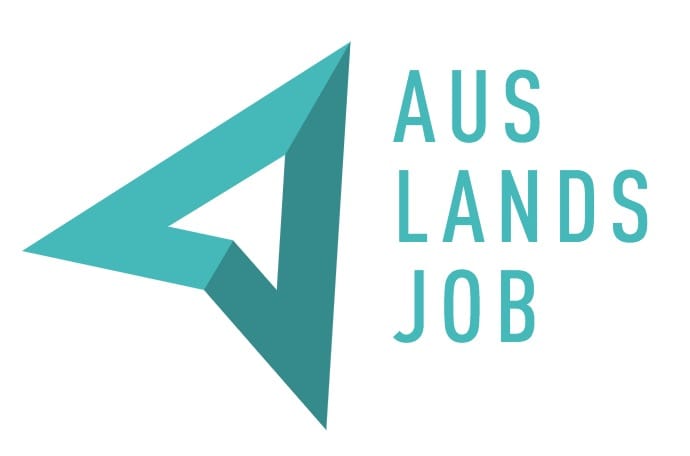
ATTENTION!!!
You browser this site using Internet Explorer 8 or lower. In order to view the website correctly, install the latest version of Internet Explorer or any other equivalent browser (Firefox, Chrome, Safari).
Working Holiday Programmes
In the context of a cultural or tourist trip, young people may spontaneously decide that they wish to enter into a limited working relationship and also use education facilities in the respective country. Working Holiday Programmes (WHP) were set up to meet the relevant demands and enable young people between 18 and 30 to finance their (holiday) stay abroad – at least to some extent – themselves, gather practical vocational experience in another country and benefit from the local educational facilities. Employment and education are thus not the primary reason for travelling abroad but are as such an incidental benefit.
Under these programmes, young people may gather professional experience abroad and acquire/improve foreign language skills, which are important aspects when starting a career. Another objective is to promote young people’s understanding of other countries and cultures.
Austria has so far concluded agreements in this regard with Argentina , Australia , Canada , Chile , Hong Kong , Israel , Japan , New Zealand , South Korea , Taiwan and the United States of America .
Austria is therefore among the top EU countries with regard to the number of concluded and effective WHP agreements.
Inquiries regarding an Austrian Working Holiday Visa should be addressed to the respective Austrian representation (see Working Holiday Application )
- Join as a Workawayer
- Join as a host
- Buy a gift membership
Workaway Host List - Find Hosts and Organisations
Meaning of the colours:
By default (toggle switch to the left) hosts who have both yellow AND green indicated for the months you have selected will be shown. If you move the toggle to the right ONLY hosts who have indicated green will be shown.
Meaning of this:
By default (toggle switch to the left) will show hosts who have ANY of the months you have chosen marked as available. This means that some of the months might be marked red (no availability.) If you need to see ALL of the months you have selected as available move the toggle to the right.
Austria
Canada
Czech Republic
Tanzania
Spain
Italy
Portugal
France
Australia
Belgium
Uganda
Ecuador
Costa Rica
Mexico

Inspiration from around the world
Your next adventure begins today
Join the Workaway community today to unlock unique travel experiences with over 50,000 opportunities around the globe.
Forgotten your password?
Workaway has committed over $20,000 USD from the Workaway foundation to help refugees from Ukraine.
Upon request all workawayers based in Ukraine will have their accounts extended for free until further notice.
Hosts in Ukraine have been temporarily disabled for safety reasons.
If you are a host and are able to take in refugees please add the information in your account and you will be added to our last minute host list .
Should you wish to donate and help please click here .
Language selection
- Français fr

Work and travel in Austria
Choose another destination

How to apply
Who can apply.
To work in Austria through a bilateral Youth Mobility program, you must:
- be a Canadian citizen
- be 18-30 years old (inclusive) for the Working Holiday Programme, or
- be 18-35 years old (inclusive) for the Intra- and Partner-Company Training Program or the Young Workers Exchange Program, and
- for example, if you’re staying in Austria for 6 months, your passport must be valid for at least 9 months
Other requirements may apply. Check Austria’s website for more details.
What type of work visa do I need?
If you’re staying:
- between three to six months, you need to apply for an entry permit (Visa D)
- more than six months, you need to apply for a residence permit
Eligible applicants can apply for one of three Youth Mobility programs:
- Intra- and Partner-Company Training Program
Young professionals employed in Canada who want to travel to receive or provide training from a partner company in Austria.
- Young Workers Exchange Program
Post-secondary graduates who want professional training in tourism, agriculture or forestry. Participants must have a degree or diploma in at least one of the three fields.
Working Holiday Programme
Canadian youth looking to travel to Austria and work temporarily to fund your trip.
Do I need a formal job or internship offer?
Yes, you need a job offer (pre-arranged contract of employment) or a formal internship offer if you apply to the:
No, you don’t need one if you apply to the Working Holiday Programme.
How long can I stay and work?
If you are taking part in the:
- Intra-and Partner Company Training Program, you can stay up to 12 months
- Young Workers Exchange Program, you can stay up to 6 months
- Working Holiday Programme, you can stay up to 12 months with an entry permit (Visa D).

Start your Adventure
About austria.
While most of Austria is mountainous, the landscape offers a lot of variety with snowy peaks, glaciers, many lakes and rivers, wide basins, vineyards and green hills and plains. Because of this, Austrians, like Canadians, embrace an outdoor lifestyle that includes hiking, mountain climbing and water sports and, of course, some of the best skiing in the world.
Austria is rich with tradition and culture. It’s common for many Austrians to wear traditional dress, such as a Dirndl (dress with apron) or Lederhosen (short leather pants), when the occasion is right. Food is a big part of Austrian culture. If you’re a fan of desserts, make sure to try a piece of Sachertorte or Apfelstrudel. Austria’s history in music is as impressive as any. Names like Mozart, Beethoven and Schubert are just a few famous composers connected to Austrian music.
Need help planning? One of IEC’s recognized organizations might be able to help you find a job, transportation, and provide travel advice.
Most recognized organizations charge a fee for their services.
The best way to make sure your trip is the experience of a lifetime is to plan. Review our travel checklist to find out what you should know or do before travelling to and working in a foreign country.
Before you leave, remember to register as a Canadian abroad to receive notifications in case of an emergency while you are abroad or of a personal emergency at home. The service also enables you to receive important information before or during a natural disaster or civil unrest.
Tourism Austria
Check for travel advisories
Living and working in Austria
Safety and travel advice for 2SLGBTQI+ travellers
Countries/territories
Select a country/territory:
- Czech Republic
- Korea, Rep.
- Netherlands
- New Zealand
- Switzerland
- United Kingdom
Page details
Working in Vienna

- Download our Moving to Vienna Guide (PDF)
Finding a job in Austria isn't easy. The majority of expats relocate to Vienna as a result of a transfer from within their company. That said, there are a number of strong industries in Vienna, and highly skilled expats may find they have the expertise to fill a gap in the local workforce.
Expats who are citizens of EU-member states can legally work in Austria without any special documentation, but those from outside the EU will need to obtain a work permit .
While English is generally spoken in business circles, expats who speak some basic German will certainly find it advantageous when it comes to securing a job in Vienna.
Job market in Vienna
As the capital of Austria, Vienna contributes approximately 25 percent of the country’s GDP. Vienna has prominent real-estate, engineering, banking and business sectors, while tourism is also a major employer in Vienna.
The city has a booming media sector and is home to the headquarters of several newspapers, radio stations and television channels. Many international media agencies have subsidiaries in Vienna and there is a large number of correspondents and journalists based in the city.
Vienna is also a major business hub within Europe and home to both branches and headquarters of major multinational corporations.
Finding a job in Vienna
Browsing online listings and social-networking sites such as LinkedIn before arriving in the country is a good idea as it allows for a quick cursory glance at the current state of the job market within a particular field. The classified section in local newspapers, and their online versions, are also a good source of information.
Expats should also make use of any personal contacts to find out about job opportunities. Networking and personal relationships are incredibly important in Austria. Austrians tend to trust friends, so personal recommendations are highly valued.
Work culture in Vienna
Vienna may be a lively and cosmopolitan city but its work culture still has old-fashioned values and perhaps less egalitarian structures than some expats may be used to. Most companies have a definite hierarchical structure, and those in senior positions, particularly those who have high qualifications and many years of experience, are highly regarded and deferred to.
Viennese work culture prides itself on the concept of Sozialpartnerschaft , or social partnership, which promotes cooperation and dialogue in matters relating to industrial relations. It is important for expat entrepreneurs and business owners to work closely and cooperate with local business partners and Austrian subsidiary companies.
Further reading
►To learn more about work customs and culture, read Doing Business in Austria
Expat Experiences "I’ve really enjoyed my work so far – though I can’t speak for everyone’s experience of work in Austria! I have a lot of autonomy, which suits me well." Read more about UK expat Tessa's experiences in Austria .
Are you an expat living in Vienna?
Expat Arrivals is looking for locals to contribute to this guide, and answer forum questions from others planning their move to Vienna. Please contact us if you'd like to contribute.
Expat Health Insurance
Cigna Global Health Insurance. Moving your family abroad can be intimidating, but learning about medical options such as family health insurance early on can help you settle successfully. Comprehensive Family coverage, wherever you go Paediatric coverage for well-child visits & immunizations Access to dental and orthodontic care 24/7 multilingual Customer Service Get a quote from Cigna Global (10% off family health plans in June)
Aetna Aetna International, offering comprehensive global medical coverage, has a network of 1.3 million medical providers worldwide. You will have the flexibility to choose from six areas of coverage, including worldwide, multiple levels of benefits to choose from, plus various optional benefits to meet your needs. Get your free no-obligation quotes now!
Moving Internationally?
International Movers. Get Quotes. Compare Prices. Sirelo has a network of more than 500 international removal companies that can move your furniture and possessions to your new home. By filling in a form, you’ll get up to 5 quotes from recommended movers. This service is free of charge and will help you select an international moving company that suits your needs and budget. Get your free no-obligation quotes from select removal companies now!
Free Moving Quotes ReloAdvisor is an independent online quote service for international moves. They work with hundreds of qualified international moving and relocation companies to match your individual requirements. Get up to 5 free quotes from moving companies that match your needs. Get your free no-obligation quotes now!


From Education to Career
We are happy to assist you as a graduate in pursuing your career in Austria and support you free of charge on your transition from your studies to entering the Austrian labour market.
Did you know...
according to the IMD World Competitive Ranking 2022
...that Austria has one of the best health systems in the world?
STUDY - Why Austria?
- There is no “numerus clausus” system which allows or denies students access to higher education on the basis of the final grades achieved in school. Instead, there are admission tests for many fields of study. Get information from the website of the university of your choice.
- As an EU member state, Austria is embedded in the European and international university landscape. For this reason, most university degrees follow the Bachelor - Master - PhD degree structure. Most universities have numerous partner universities abroad in both Europe and globally. A semester abroad is perfectly normal for many students in Austria. Find more advantages for living in Austria here .
- Tuition fees for Austrian students and students from EU/EEA member states are only charged for universities of applied sciences, private universities and if a person studies longer than the stipulated duration of studies. Regularly enrolled students from countries outside of the EU/EEA have to pay € 726.72 per semester. Every student must pay € 24.70 per semester for the Austrian Student Union (ÖH).
- There are many funding possibilities and scholarships available. Search here on the Website to find possible scholarships you can get.

Austria is like a cheeky teenager, full of charm, diligence and conviviality.
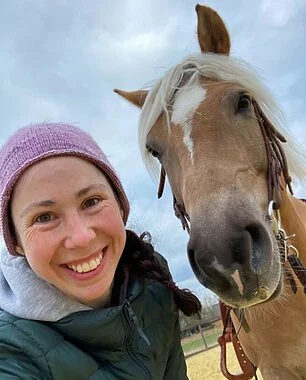
STUDY – Studying and working in Austria
The steps you have to take in order to be allowed to work alongside your studies depends on your nationality, amongst other factors.
Studying in Austria
You will find the information you need about entering the country, staying in Austria and being admitted as a student, working as an artist or as researcher at a university here and on the website of the Austrian Agency for Education and Internationalisation ( OeAD ). Here you can learn more about the right course of studies for you, and grants.at provides details about all Austrian scholarship programmes. The OeAD is also the right contact for any legal issues r relating to studying in Austria.
Working in Austria as a student from an EU/EEA country
As an EU or EEA citizen, you have unrestricted access to the Austrian labour market during your studies. You can work as a marginally employed person, part-time or full-time and also do traineeships or internships. However, it is important that your studies are not negatively affected and that you are officially registered in Austria. You must get a Registration Certificate (“Anmeldebescheinigung”) for this purpose. Read more
Working in Austria as a student from a third country
If you are a third-country national with a Residence Permit – Student and would like to work up to 20 hours per week alongside your studies, you can do so with a work permit (“Beschäftigungsbewilligung”) for which your employer can apply to the Austrian Public Employment Service (AMS). Within the context of the application process, the AMS will check to see if you have a valid with a Residence Permit – Student and whether the application includes all the required documents from your employer. You also require a work permit even if you are only in marginal employment.
If you are a third-country national with a Residence Permit – Student and would like to work more than 20 hours per week alongside your studies, the AMS may carry out a special procedure called a labour market test (“Ersatzkraftverfahren”) as part of your application for a work permit. In this process, the AMS determines if other skilled workers are already registered for the specific position. Only if this is not the case will the work permit be granted.
Doing a traineeship/internship in Austria
Are you a third-country national, studying at a university or university of applied sciences and the traineeship or internship is part of your studies? In this case the employer need not apply for a work permit for you. It is sufficient if he reports the studies to the AMS in a timely manner. Your university must confirm in writing that the traineeship or internship is necessary to complete your studies or will be credited to your studies. Our blog provides additional information on how to do a traineeship as a third-country national.
Do you want to do an Erasmus+ semester or Erasmus+ traineeship while studying in Austria? This is possible if your university offers Erasmus+ . We recommend contacting your university and the Austrian Agency for Internationalisation and Education ( OeAD ). You will also find further information on internships at the international organisations AIESEC and IAESTE .

Most international students studying in Austria come from Germany, Italy, Iran, Serbia, Syria and India.
...that many students currently registered at Austrian universities come from various countries?
START – Begin your career
We will help you with everything you need to know on entering the Austrian job market as an EU/EEA citizen or third-country national.
Find your dream job
Search for your mission in life with us! With jobs in companies and startups throughout Austria, our ABA Job Platform offers you possibilities to work in many sectors and fields, many of which are in English and German. If you have not yet successfully concluded your studies in Austria or if you graduated a long time ago, inform yourself about your options in entering the labour market by using our Immigration Guide .
How to apply for a job in Austria
In Austria it is customary to include a photo of yourself with your curriculum vitae as well as a motivational letter when contacting a company and applying for a job. The motivational letter should clearly state your motivation to work at the advertised position and for the company and how your qualifications fulfil the demands stipulated in the job advertisement. Our blog contains answers to questions relating to applications for jobs with Austrian companies.
Start your career after graduation as an EU/EEA national
EEU/EEA nationals can travel to Austria without a visa and work without a work permit. However, EU/EEA nationals have to report their place of residence within three days and apply for a Registration Certificate ("Anmeldebescheinigung") at the responsible office of the Immigration Authority within four months after entering the country. Find out more here .
Start your career after graduation as a third-country national
If you want to work in Austria after your studies but have not yet found a job, you can extend your Residence Permit – Student for twelve months after graduation. During this year you can search for a full-time job matching your qualifications and work as a self-employed person thanks to the Residence Permit – Student or you can obtain a work permit to enable you to work as a salaried employee during this time. All the information you need can be found here .
If you have already found a full-time job after concluding your studies, the Red-White-Red – Card for Graduates (“ Rot-Weiß-Rot – Karte für StudienabsolventInnen ”) is the best solution for you. We will be happy go advise you on all issues relating to the Red-White-Red – Card.

I have always wanted to live in Austria since I was a child. And I made this dream come true.
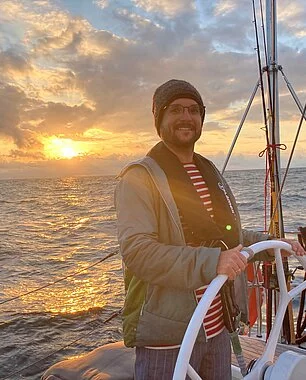
STAY – living in the Austria in the longer term
We offer you all the necessary information about living in Austria, ranging from getting residence permits to purchasing an apartment or starting your own family.
Salary expectations – what can I expect?
We will answer your questions on calculating salaries or employees in your field and what you can personally expect. Write us an email and we will check it out for you.
Life and Culture in Austria – how is it?
Do you have questions on living in Austria, on the healthcare or educational system, which public authority you have to report to or on purchasing a car? Our Essential Guide on Living and Working in Austria is available to you free of charge .
Establishing startups – how can I set up my own company?
We support you on any issues relating to founding your own business or startup. Our INVEST in AUSTRIA department provides information on all aspects such as financing, investment capital and legal advice.
Finding ABA – at what events can I talk to the ABA?
ABA takes part in many job and career fairs throughout Austria, offers individual consultations on site, gives webinars and will work together with your university and international partners to show you the best path for you to take. Learn more

The Red-White-Red Card for Graduates applies to third-country nationals who graduated from an Austrian university and found a job offer applicable to their studies. Get more information here!
...that a special work permit and residence permit exist for international students who graduate from an Austrian university?
Frequently Asked Questions
We simply make it easy.
WORK in AUSTRIA is the point of contact for specialists who would like to work in Austria as well as for companies looking for suitable specialists. We advise you free of charge.
Get in touch
We use cookies to ensure that we give you the best experience on our website. Find out more in our Privacy Statement .
- Mobility and Travel
Working Holiday in Germany
Traveling through Germany one year long and replenishing the holiday fund with summer jobs: we present the Working Holiday Programme.
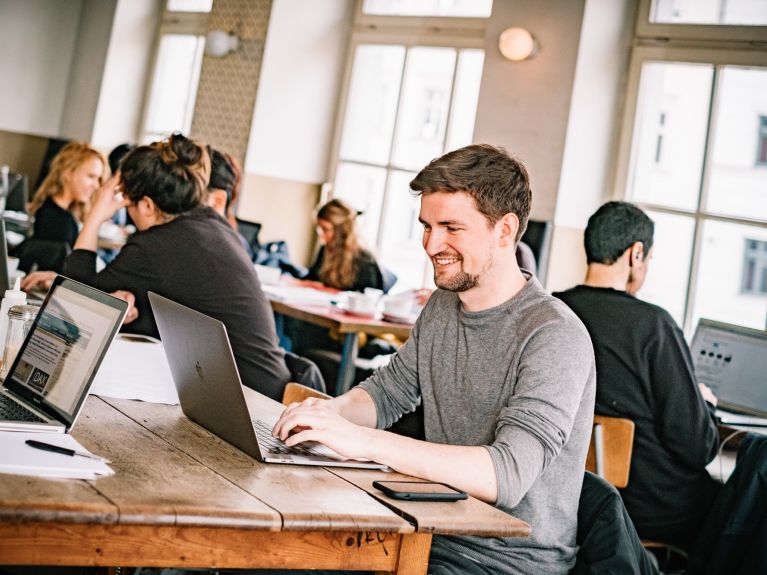
Experience the country and its people, culture and everyday life, earn money and learn the language through jobs – Work and Travel and Working Holiday programmes are a great way to get to know a country really well. These are the requirements for working holidays in Germany.
Who can participate in the Working Holiday Programme?
Bilateral Working Holiday programmes exist between Argentina Australia , Chile , Hong Kong , Israel , Japan , South Korea , New Zealand , Taiwan and Uruguay . Brazil is to join soon.
Canadians can travel to Germany via the Youth Mobility Program (YMP) and work in the country or do an internship related to their university studies.
Is there an age limit for Work and Travel?
Yes, at least 18 and at most 30 years. Only with the Youth Mobility Program is the age limit extended to 35 years.
Do I need a visa for a working holiday in Germany?
Yes, a Working Holiday Visa (WHV). It is valid for twelve months.
Where can I apply for my working holiday visa?
Usually in advance at the German diplomatic missions in the respective country. Only Australians, Israelis, Japanese, Canadians and New Zealanders can apply for the visa even after entering Germany.
What else should I bear in mind?
Work and Travelers must have health and accident insurance valid for Germany and financial reserves of about 2,000 Euro. Often a return ticket is also required or proof of the necessary money for one. How many months participants in the Working Holiday Programme are allowed to work in Germany and how much money they have to prove as security is regulated differently in the bilateral agreements. You should therefore inform yourself at the websites of the German Embassy in your country about details. The portal nomadenberlin.com also provides helpful information in English.
What jobs are there?
Work and travel jobs are not full-time jobs, but temporary and summer jobs. There are many offers in tourism, in call centres, in online business and in agriculture. When looking for a job, the Job Centre in each city provides help. Or look in job exchanges like monster.de , stepstone.de and indeed.com for holiday jobs or Work and Travel.
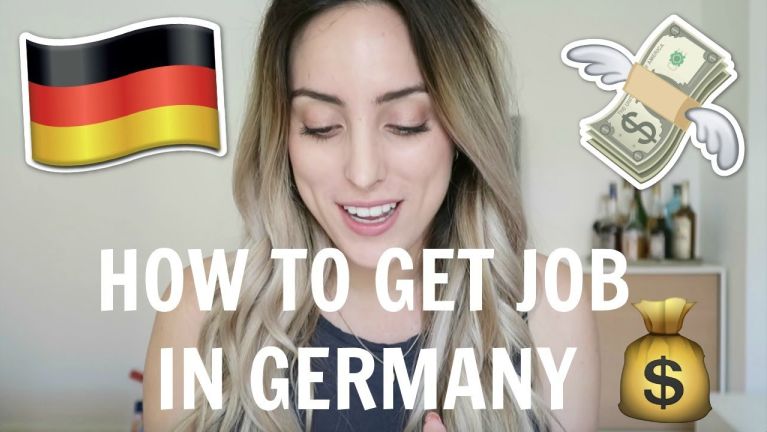
Dieses YouTube-Video kann in einem neuen Tab abgespielt werden
Third party content.
We use YouTube to embed content that may collect data about your activity. Please review the details and accept the service to see this content.
Piwik is not available or is blocked. Please check your adblocker settings.
How well do I have to speak German?
You should have at least a basic knowledge. As a rule of thumb, the more demanding the job, the better language skills that are needed.
Are there alternatives to Work and Travel?
You can work as an au pair in a family, apply to a German company for an internship or do volunteer work .
© www.deutschland.de
Related content

- EN - English
- PT - Portuguese
- ES - Spanish
- How it works
- Become a Host
- Download the app
Top Destinations
- United States
- United Kingdom
What type of experience are you looking for?
- Non-Profit School
- Permaculture project
- Eco Village
- Holistic Center
- Guest House
- How Worldpackers works

Learn from the most experienced travelers of the community
Traveling with worldpackers, planning and budgeting for travel, make a living while traveling as a lifestyle, travel with worldpackers.
- Using Worldpackers
Work exchange
- Social impact
Plan your trip
- Women traveling
- Budget travel
- Solo travel
- Language learning
- Travel tips
- Get inspired
- Digital nomads
- Travel jobs
- Personal development
- Responsible travel
- Connect with nature
Top destinations
- South America
- Central America
- North America
- More destinations
- WP Life WP Life
- Exclusive discounts Discounts

Filtering by:
Program types.
Exchange your skills for accommodation
Higher chance of approval
Hosts that recently have approved volunteers and are looking for more applications
Hosts that have good ratings and receive many worldpackers
Opportunities for couples and pairs
Hosts that welcome couples or two friends traveling together
Purpose of the trip
- Immerse yourself in the local culture
- Connect with the locals
- Connect with international travelers
- Practice English
- Practice Spanish
- Expand your social consciousness
Availability
Last minute.
Needs help immediately
How do you help
- Welcoming & Helping Guests
- Housekeeping
- Kitchen Hand
- Night Shift
Hours of collaboration per week
Travel length.
Medium Term
- At least one
Accommodations
- Shared Dorm
Additional Benefits
- Bikes at your disposal
- Use our equipped kitchen
- Discounts on Drinks
- Free Laundry
Work Exchange and Volunteer programs in Vienna
1 opportunity found

Hostel Vienna, Austria
Free stay in an international atmosphere in a beautiful city!
- High demand
Join the community!
Create a free Worldpackers account to discover volunteer experiences perfect for you and get access to exclusive travel discounts!
How do Worldpackers trips work?
As a member, you can contact as many hosts and travel safely as many times as you want.
Choose your plan to travel with Worldpackers as many times as you like.
Complete your profile, watch the video lessons in the Academy, and earn certificates to stand out to hosts.
Apply to as many positions as you like, and get in contact with our verified hosts.
If a host thinks you’re a good fit for their position, they’ll pre-approve you.
Get your documents and tickets ready for your volunteer trip.
Confirm your trip to enjoy all of the safety of Worldpackers.
Have a transformative experience and make a positive impact on the world.
If anything doesn’t go as planned with a host, count on the WP Safeguard and our highly responsive support team!
After volunteering, you and your host exchange reviews.
With positive reviews, you’ll stand out to hosts and get even more benefits.
One Day in a City
24 Hour Travel Itineraries to Make the Most of a Day in a Destination
The Ultimate One Day in Vienna: Must-Have Itinerary for Visiting Vienna in 24 Hours
November 11, 2023 By Gina Posts on this site may contain affiliate links. Read the full disclosure here .
The Best Things to See and Do in Vienna in One Day
Short on time in Vienna? This super detailed and helpful 1-day Vienna itinerary is here to help.
I love Vienna…the alluring blend of art, music, and grandeur of the buildings gives it a different feel from other major European cities. While I think everyone should spend multiple days in Vienna, sometimes that just isn’t possible, and one day in Vienna is of course better than zero days. So if you find yourself with the opportunity to visit this city, even just for 24 hours – go!
To make that easier for you, I’ve created this detailed One Day in Vienna itinerary so you can keep yourself from feeling overwhelmed about filtering through the things to do and choosing what to see while in Vienna. I’ve included “One Day” tips for each recommended site to help you maximize your time. In addition, there are sites and things to do under the “Modified Itinerary” section that is more interest-specific depending on your favorite things to see and do while traveling. Here’s a quick breakdown of what you’ll find in this article: – Best Time to Visit Vienna – One Day in Vienna Itinerary Outline -Detailed 24-Hour Itinerary – Where to Stay -Itinerary Modification Ideas – Where to Eat – Getting Around Vienna
Here’s an infographic for you, too, to get a visual idea of your day before reading the itinerary.
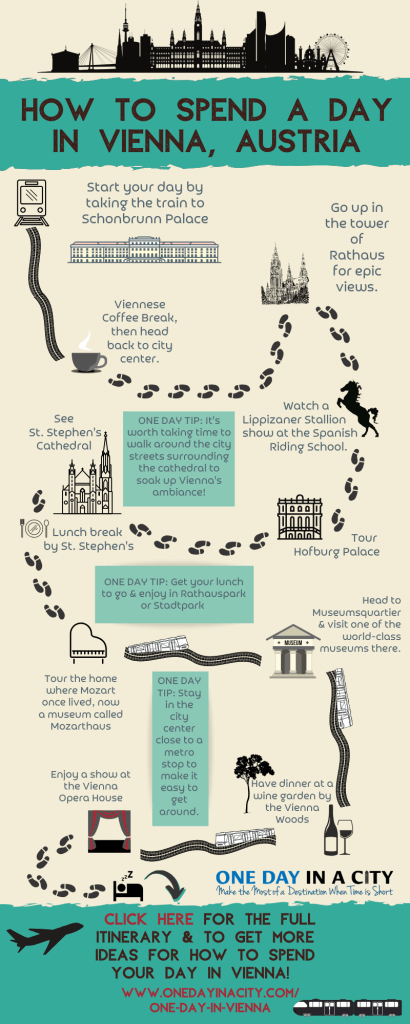
Best Time to Visit Vienna
Depending on your interests, July and August may not be the ideal time for you to visit. During those months the famous Vienna Opera House is closed as the musicians are on vacation. While other performances in stunning old Viennese buildings still happen, those who have their heart set on seeing an opera in the Vienna Opera House should aim to visit during a different month than July or August.
In addition, those who are looking forward to seeing the famed Lipizzaner horses of the Spanish Riding School in all their glory should note that horses get vacation, too, and during July and August they are on a farm in the country – though shows featuring some of the younger, not yet fully trained horses (and foals) are still conducted.
Vienna in a Day Itinerary Outline
Here is an outline of the itinerary and then I’ll get into the details for each thing to do in Vienna below:
Time needed: 1 day
One Day in Vienna Recommended Itinerary
Start your day by heading out of the city center to tour the elegantly impressive Schönbrunn Palace and grounds.
See the City Hall of Vienna and learn more about Austria’s government.
Experience the wonders of Lipizzaner stallions at this one-of-a-kind show.
A stately palace located right in the city center of Vienna.
Tour a house where Mozart lived and learn more about the famous composer.
See the ornate grandeur of this iconic opera house.
If you’re a museum person, choose one to visit in this museum-focused neighborhood of Vienna.
An incredible cathedral right in the heart of the city.
A bonus architectural masterpiece to see if time allows.
Also in this guide are tips on where and what to eat in Vienna, hotel recommendations, Vienna’s cafe culture info, and what to pack for your one day in Vienna.
For the optimal itinerary to experience a wide range of Vienna in a short amount of time – and especially for those who are visiting Vienna for the first time, I’ve put together a recommended itinerary of how you should spend your day in Vienna (modified itinerary recommendations depending on your special interests are listed afterward).
Schönbrunn Palace

Though it’s a bit of a trek to get to, Schönbrunn Palace is still a must to make time to see even if short on time in Vienna. Schönbrunn Palace was the summer residence of the Habsburgs in Vienna and it’s an elegant, stately masterpiece to behold.
Schönbrunn Palace was the summer residence of the Habsburgs in Vienna. After the original palace that stood on the grounds was destroyed in 1683, a hunting lodge was put up instead. The hunting lodge stayed until Maria Theresa rose to power; she had the lodge reconstructed into the glorious Schönbrunn Palace and spent summers there. Her servants numbered in the hundreds and the buildings and grounds of Schönbrunn reflect that as there had to be enough space for her servants to live there, too.
One thing you’ll note of Schönbrunn Palace is how warm the coloring of the palace feels. That also is thanks to Maria Theresa who had the palace decorated in walnut paneling with plenty of ornate touches and décor in predominately browns and reds.
In addition to the overall décor and ambiance of Schönbrunn Palace, other notable palace rooms include:
Bedchamber: The bed in this room was where Emperor Franz Josef (who ruled from 1848 to his death in 1916 and was the great-great-grandson of Maria Theresa) died and a painting of him on his deathbed is located in the room. You can also see his grooming tool, which is still the original.
Lavatory of Franz Josef: Note that this is not very elaborate compared to other rooms in Schönbrunn Palace (and most other palaces from the time period) as Franz Josef lived a very frugal lifestyle.
Dressing Room: This room is impressive to behold as it includes a mannequin with an example of Sisi’s hair (Sisi was the nickname of Empress Elisabeth, the beloved wife of Franz Josef), which was so long it reached her ankles. It took hours for servants to do her hair each day.
Bedroom of Franz Josef and Elisabeth: Decorated in beautiful blues and greens.
Family Dining Room: Franz Josef often ate here and enjoyed traditional dishes for special occasions, like Wiener Schnitzel. Sisi rarely joined him in this room as she didn’t eat much in order to retain her figure.
Children’s Room: Here you’ll see the pictures of Maria Theresa’s 11 daughters, all of whom were married off for political reasons except one: Maria Christine. It was well known that Maria Christine was Maria Theresa’s favorite daughter and she was the only one allowed to marry for love.
Mirror Room: Used for family celebrations and small concerts. A notable fact about this room is that Mozart gave a performance in it at the age of 6 in 1762.
Great Gallery: This long room was used for ballrooms, receptions, and banquets. It has excellent examples of rococo art, including frescoes depicting the glorification of the Maria Theresa reign.
Chinese Cabinets: Maria Theresa loved Asian art and these small, beautiful rooms served as a place for card playing and meetings, including secret ones that Maria Theresa would have with her most trusted advisors.
Carousel Room: Has a large painting of the Ladies’ Carousel held by Maria Theresa at a winter riding school after the War of the Austrian Succession as a celebration of the recapture of Prague. Maria Theresa is riding a Lipizzaner horse in the painting.
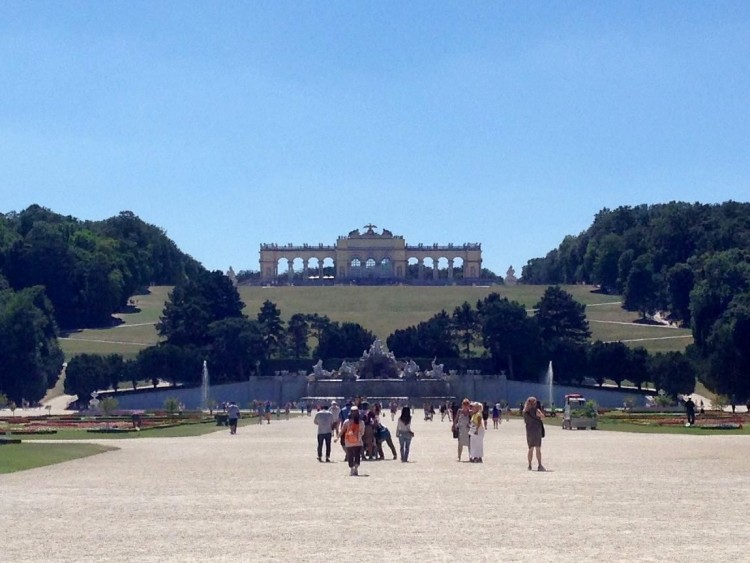
The Grounds of Schönbrunn Palace also have sights you can’t miss:
Garden Maze: The maze, of which there are three interconnected ones, takes about 30 minutes to walk through and opens up to the playground, making Schönbrunn Palace an ideal place to visit in Vienna with kids. One Day Tip: If you don’t have kids, skip the maze unless you absolutely love mazes – there are other sights to see in Vienna that you should be spending your day visiting.
Walking Paths: There are several walking paths to get from the palace up to the Gloriette, an open-air structure that is the highest point on the grounds and provides amazing views of the city of Vienna. You can opt for paths that wind through the woods or open paths zigzagging up the hill along prettily planted flowers and bushes.
Café Gloriette: After doing the slightly strenuous walk up the hill to the Gloriette, take a quick break to enjoy a Schokochino at Café Gloriette. The Schokochino is thick, creamy, frothy coffee goodness with a hint of chocolate flavor. It comes topped with whipped cream, but it’s not sweet; instead, the chocolate just adds to the creaminess of the drink.
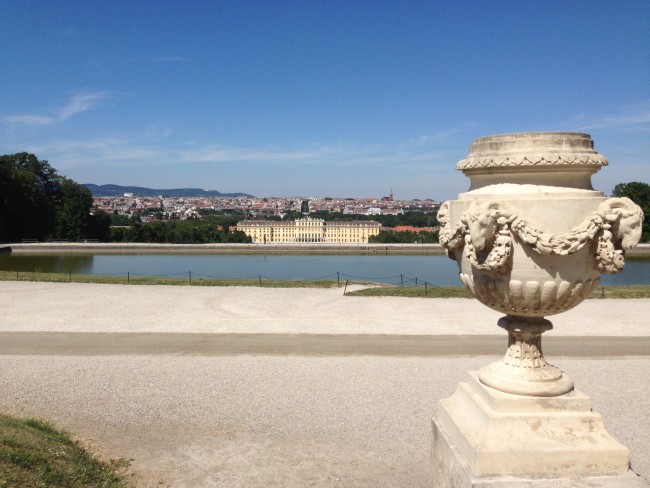
Schönbrunn Palace Quick Facts Address: Schönbrunner Schlossstrasse 47 Metro: Schönbrunn (U4 Line) Hours: April 1 – June 30 and September 1 – October 31, 8:30 a.m. – 5:30 p.m.; July 1 – August 31, 8:30 a.m. – 6:30 p.m.; November 1 – March 31, 8:30 a.m. – 5 p.m. Phone: 43 1 811 13 0 Cost: Adults, €11.50; Children (ages 6-18), €8.50; Students (ages 19-25 with International Student ID), €10.50. (These ticket prices are for the Imperial Tour. The Grand Tour, which includes the rooms of Maria Theresa, costs a few euros more, and the Classic Pass is several euros on top of that, which also includes access to the Crown Prince Garden, the maze, and Gloriette – all of these can also be bought separately later on during your time at the palace.) Note: If you bring a backpack or large purse you will need to check it. One Day Tip: Opt for the Imperial Palace tour, which takes about 40 minutes and includes the opulent state rooms and private apartments of Franz Joseph and Sisi. Allow yourself an additional 40 to 60 minutes for walking around the grounds. Also, try to visit Schönbrunn Palace first thing in the morning before the crowds get really thick. You’ll be able to tour it faster and then have the rest of the day to explore the other can’t-miss sites of Vienna.
Rathaus is the city hall of Vienna and is the seat of the mayor plus houses the city council. It was built in 1883 and is an example of Historicism architecture, which blends historic architect styles of the past with a new style that is all its own.
The tower is the most reminiscent of a specific architecture style thanks to its Gothic look. While visiting Rathaus, be sure to look for the Rathausmann, a knight sculpture atop the tower which stands guard over the city. The Rathaus Tower is accessible via 331 steps which take you up spiral staircases to a landing with great views of Vienna, but if you only have one day in Vienna you may want to skip making this trek unless you really want the photo op.
Spanish Riding School
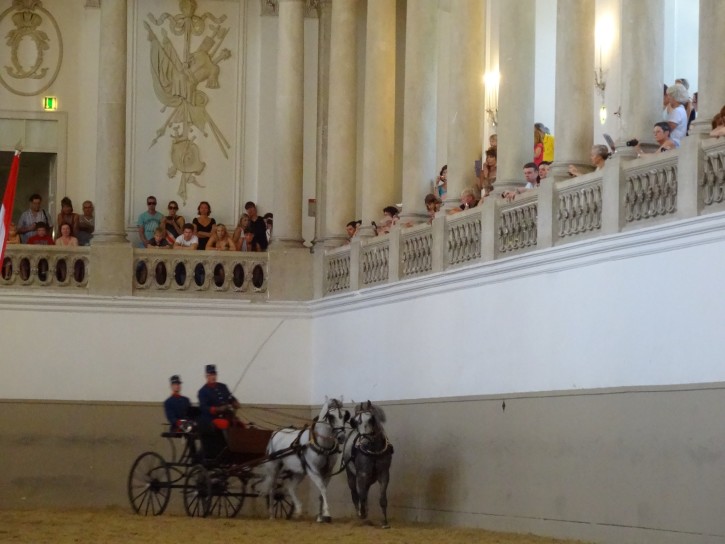
The Spanish Riding School is where the famous Lipizzaner stallions and their riders are trained. The Lipizzaner horses have been bred for the past 200 years and the Spanish Riding School preserves classical equitation, which works to create the perfect harmony between horse and rider.
The Lipizzaner stallions are bred to be the perfect mount for classical horsemanship and for carriage-pulling. A carriage pulled by four horses is considered to be the utmost in carriage driving. The two horses in front are elite and lead the carriage, while the two in back are the pull horses – they provide the strength. These horses must be impeccably trained and must readily respond to the sound of the driver’s voice. Witnessing this type of carriage pulling at the Spanish Riding School gives you an excellent example of the training and elegance the Spanish Riding School is known for.
While at the Spanish Riding School, you’ll also learn about how the horses are selected to be in the performances. It starts with the breeding. Broodmares are specifically chosen to continue strong lines and the foals of the broodmares signify ancestry and character. As foals, they must prove they can learn the appropriate skills and then at six months they are weaned.
The horses learn very early to lift their feet (you’ll see why this is important during a performance at the Spanish Riding School) and are groomed daily so they immediately feel comfortable with humans. At one year the male foals are separated from their mothers and spend the summer in the mountains for training. The rest of the year, these talented stallions perform around the world, including at the Spanish Riding School, where you’ll feel like you’ve been transported back into the Renaissance era while watching a performance.
Spanish Riding School Quick Facts Address: The Visitor Center is at Michaelerplatz 1, which is adjacent to the Spanish Riding School arena. Metro: Herengasse (U3 Line) Phone: 43 1 533 90 31 Hours: Visitor Center hours are open Monday – Saturday 9 a.m. – 4 p.m. (and 7 p.m. on Fridays when there is a performance). Performance times and days can vary depending on the time of year though typically there is a performance at 11 a.m. on days when the Spanish Riding School is performing. Cost: Tickets range from €8 to €130 depending on show type and seating area. Reserving your ticket in advance is highly recommended and can be done so at www.srs.at. One Day Tip: This is one place you’ll want to arrive at least 15 minutes early as you’ll have to get in one line to pick up your tickets (at the Visitor Center) then get into another line to get into the arena. Also, to save time, plan on seeing Hofburg Palace before or after the Spanish Riding School performance as the arena is located on the property of Hofburg Palace.
Hofburg Palace
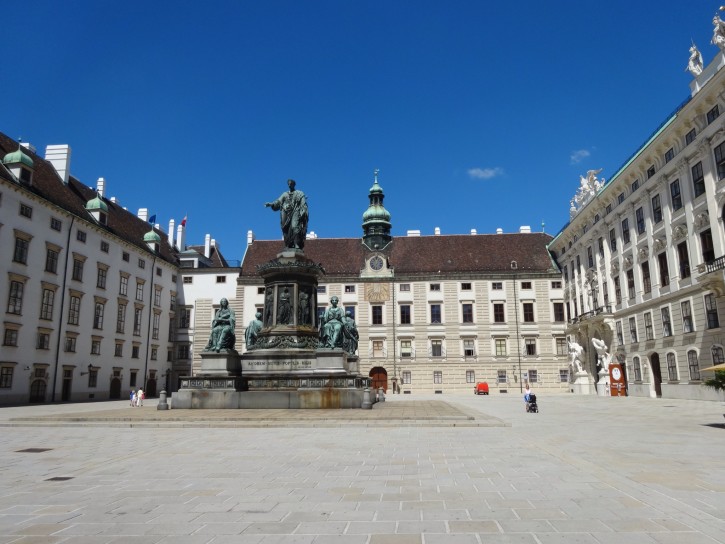
The Spanish Riding School is located in Hofburg Palace, which also is worthy of some of your time in Vienna.
Hofburg Palace, also referred to as the Imperial Palace, has been the home of many members of Austrian royalty, like the Habsburgs, and is still lived in today by the President of Austria plus is the location of the offices for the ministers of the chancellor’s office and the secretaries of state.
During the rule of the Habsburg family, Hofburg Palace served as the center of the Holy Roman Empire as well as the seat of the government and its administration. While visiting Vienna, you can just walk around the Hofburg Palace complex to see its array of different architecture, ranging from Neoclassical to Baroque due to constant expansion over 600 years.
If you’re worried about time, you can quickly walk around the Hofburg Palace complex to see its array of different architecture, ranging from Neoclassical to Baroque. However, if you’re a big fan of Emperor Elisabeth or love old palace décor, you may want to make time to visit Hofburg Palace’s two onsite museums: the Sisi museum (Sisi was Empress Elisabeth’s nickname) and the Imperial rooms of the palace.
Sisi Museum
The Sisi Museum located in Hofburg Palace is a museum dedicated to Empress Elizabeth, who became a beloved icon of Austria during her reign in the 19th century and was mostly called by her nickname, Sisi. Married to Emperor Franz Joseph I and known for her elaborate hairdos and fashion, Sisi loved the finer things in life while also rebelling against the royal life. The museum focuses on her life as a young girl in Bavaria to her life as the Empress of Austria, including her love for traveling and riding horses, to her assassination in 1898 as well her inner conflict of being in the public eye. The Museum of Sisi also houses some of her personal artifacts, including some of her elaborate fashion from that era, and the best paintings of her.
Imperial Rooms
Though most rooms of Hofburg Palace are still used for governmental purposes, the Imperial Rooms are open to the public and can be toured to get a glimpse of life as it was during the Habsburg era. During your time in the Imperial Rooms, you’ll learn more about the Habsburg family and how they lived as Hofburg Palace served as the winter residence of the Habsburgs for over 600 years. The Imperial Rooms include the apartments of Franz Joseph and Sisi, which includes bedrooms, exercise rooms and dressing rooms, still decorated as they would have been in the 19 th century.
Hofburg Palace Quick Tips Address: Innerer Burghof Phone: 43 1 533 75 70 Metro: Herrengasse (U3 Line) Hours: September – June, 9 a.m. to 5:30 p.m.; July – August, 9 a.m. to 6 p.m. Cost: Adults, €11.50; Children ages 6 – 18, €7; Students ages 19 – 25, €10.50. Includes Sisi Museum and Imperial Rooms plus an audio guide; tours with a human guide costs €2 more, last 55 minutes, and are offered daily at 2 p.m. One Day Tip: If short on time, just walk around the grounds open to the public and skip a museum unless you’re very interested in learning more about Sisi or enjoy historic architecture. You’ll learn a bit about her during the audio tour at Schönbrunn Palace and the Imperial Rooms are also similar in style to what you’ll see at Schönbrunn Palace.
Vienna State Opera & Musical Performance
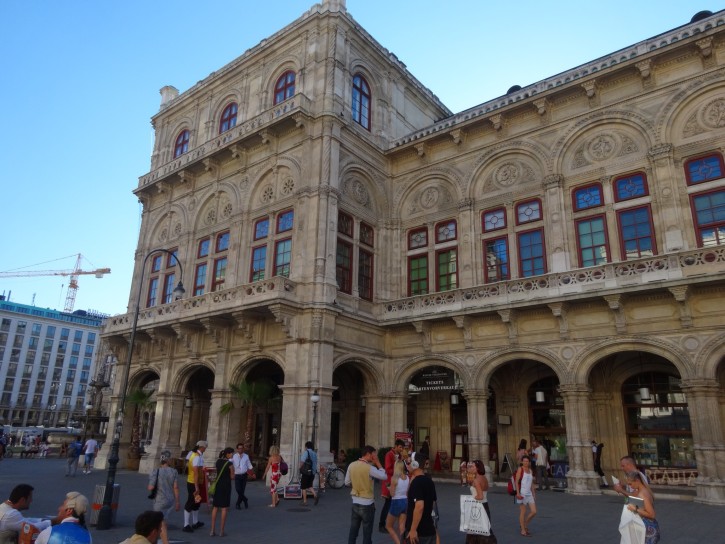
Now we’re onto the music part of your time in Vienna.
The musical side of Vienna is one you cannot miss experiencing during your one day in Vienna.
The Vienna State Opera is Vienna’s most famous musical landmark and you should at least walk by it to take in its beautiful ornate architecture and see the stars of composers lining the ground – a more sophisticated version of Hollywood’s Walk of Fame.
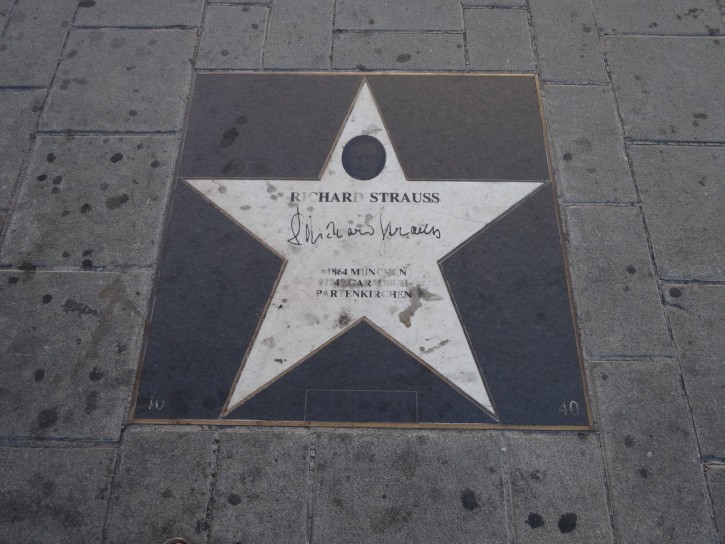
The Vienna State Opera (Wiener Staatsoper in German) is Vienna’s premier opera house and one of the most famous opera houses in the world. The Vienna State Opera opened in 1869 after careful designing for optimum sound by architect August Sicard von Sicardsburg. Starting with the performance of Mozart’s Don Juan, the Vienna State Opera has had a long history of incredible performances.
The sound engineering of Vienna State Opera got an updated overhaul in the 1940s after tragic bombings were inflicted to the building by the Nazis during World War II. The opera house was painstakingly rebuilt and reopened in 1955.
After being the place of persecution during World War II under the Nazi regime when many members of the opera house were driven out of Vienna or killed during the war and when most musical works of art were not allowed to be played, the rebuilding of the Vienna State Opera was symbolic of the rebuilding of Vienna and its new independence after the war.
Visitors to Vienna can opt to take a guided tour of the Vienna State Opera to learn more about the history and present day operations of the beloved institution. Inside the opera house, look for these elements while touring the famous building:
Frescoes: The famous “Zauberflöten” (meaning Magic Flute) series of frescoes on the veranda of Vienna State Opera. These frescoes were painted by Moritz von Schwind, a prominent artist of the era.
The Grand Staircase: Gorgeous to behold and one of the few parts of the opera house that was spared damage during the World War II bombings.
Schwind Foyer: Also spared during bombings, this ornate foyer has a beautiful frescoed ceiling, painted by Moritz von Schwind, a Vienna-born painter.
Performance Hall: This is where the musical magic happens. The Performance Hall of the Vienna State Opera is considered one of the best concert halls in the world for a reason: not only is it a gorgeous circular space, the design of the hall creates beautiful sounding acoustics.
The guided tour also provides access to the State Opera Museum, which is open Tuesday through Sunday and includes information and artifacts about performers who have wielded their talents at the Vienna State Opera House, as well as the history of the museum.
Vienna State Opera Quick Facts Address: Opernring 2 Metro: Karlsplatz (U1, U2, or U4 Line) Phone: 43 1 514 44 78 80 Hours: Tour times vary by day and time of year. Check here for tour times on the day you want to visit. For a guaranteed tour of the stage area as well, opt for the 10 a.m. tour on Sunday. Also note that on Mondays the State Opera Museum is closed so is not included in the tour. Cost: Adults: €6.50; Seniors 65 and older, €5.50; Students, €3.50. Tickets are €1.50 less on Mondays when the State Opera Museum is closed. One Day Tip: The guided tour lasts 40 minutes. Give yourself more time to see other Vienna sites during the day by visiting the Vienna Opera House at night while taking in a performance. Tips on getting tickets to a performance can be found under the Nightlife section of this guide.
One Night Tip: If you can, see a show at the Vienna State Opera, but don’t worry if it’s sold out or you’re there in July and August during its hiatus as there are plenty of other wonderful places to hear music in Vienna, including my favorite, the Musikverein where you can see the Vienna Mozart Orchestra perform in historical costumes and wigs. The musical shows are often in the evening and make a good ending to your day in Vienna.
But before you get to the evening part of your day in Vienna, there are still other sites to see, including additional musical ones, like the Mozart House…
Mozart House
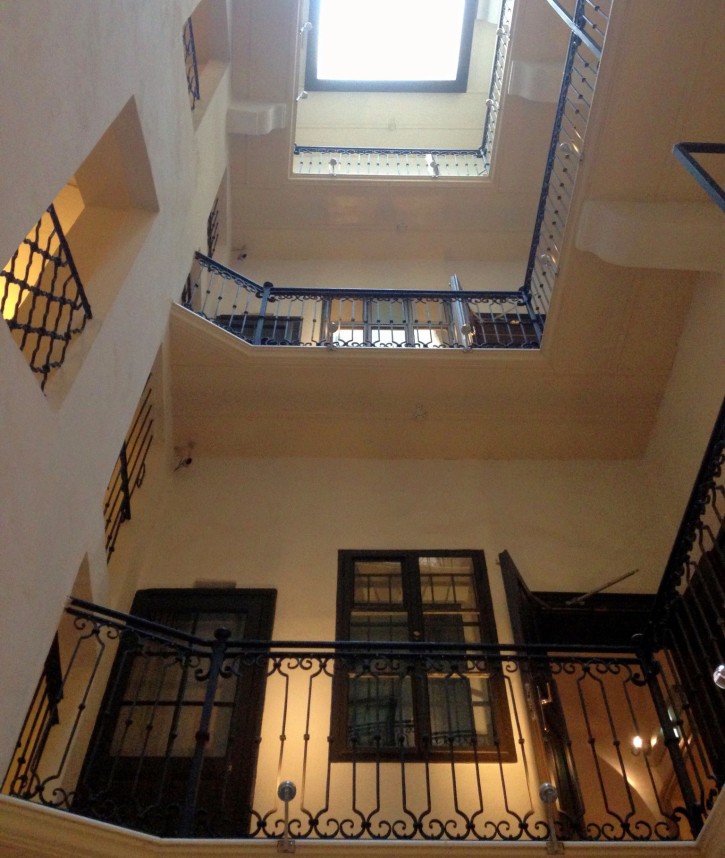
One of the most famous residents of Vienna’s past is the composer, Wolfgang Amadeus Mozart. In 1781, at the age of 25, Mozart moved to Vienna after giving up his teaching position in Salzburg. He spent the most profitable years of his life in Vienna in the apartment now known as the Mozart House, which you can tour during your time in Vienna.
During the tour of the Mozart House, you’ll see important memorabilia from Mozart’s time on this earth, including some of his musical compositions, pictures of him and his wife, and his death announcement. You’ll also learn about his family, his gambling issues, his aristocratic connections and love for the finer things in life, how he made money as an “avant-garde free musician,” and his work for the Imperial Palace of Vienna.
You’ll also get a sense for how Mozart and other affluent people lived in the 18 th century as you walk through each room of the house.
Mozart House Quick Tips Address: Domgasse 5 Metro: Stephansplatz (U1 or U3 Line) Phone: 43 1 512 17 91 Hours: Open daily, 10 a.m. – 7 p.m.; last admission at 6:30 p.m. Cost: Adults, €10; Children 14 years and younger, €3; Family Ticket (2 adults and up to 3 children), €20. Ticket includes an informative audio guide. One Day Tip: If you’re feeling short on time, choose the two rooms of most interest to you to listen to the audio guide. In the other rooms, scan the information cards and listen to the numbers that most interest you and skip the rest; this will help you get through Mozart House more quickly while still getting a large amount of history and information out of your experience.
St. Stephen’s Cathedral
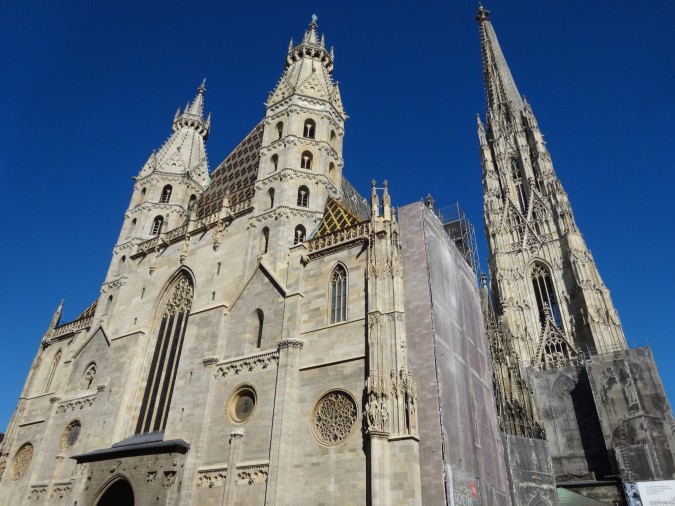
If there’s one historic church you should see while in Vienna, it should be St. Stephen’s Cathedral.
St. Stephen’s Cathedral (referred to as Stephansdom in Vienna) combines Romanesque and Gothic architecture that blends together impressively as its prominent spire juts up from the city center. Construction on St. Stephen’s was started in the 12 th century (though it underwent extensive rebuilds after World War II) and since then has been a prominent landmark in central Vienna. The church is of Roman Catholic denomination and still holds weekly masses. While touring the church, take note of the following aspects:
The Pulpit: Carved in stone by Anton Pilgram, the impressive pulpit was built in the 1500s and is located under a soaring Gothic ceiling.
The Virgin’s Choir: This Baroque section of the church is home to the opulent Wiener Neustädter Altar, a winged altar depicting scenes from the life of the Virgin Mary and which dates back to 1447.
South Tower (Steffl): Head up the more than 340 steps to get to the top of this tower for glorious views of Vienna.
Catacombs: This is where some of the bodily remains of the Habsburgs are kept, including urns of their entrails. You’ll also see where bishops are buried. In addition, you’ll see creepy sights like a pile of bones left over from the Black Plague stacked up in the catacombs like firewood. The catacombs can only be seen through a guided tour.
St. Stephen’s Cathedral Quick Tips Address: Stephansplatz 3 Metro: Stephansplatz (U1 or U3 Line) Phone: 43 1 515 52 37 67 Cost and Hours: Walking around the cathedral on your own is free and can be done Monday – Saturday, 6 a.m. – 10 p.m. and Sunday, 7 a.m. – 10 p.m. Note that during mass you won’t be able to have as much free range to walk around. The catacombs and the towers require a fee to access with more limited hours: Catacomb Tour: Adults, €5; Children 14 years and under, €2; with tours leaving every 15 – 30 minutes Monday – Saturday from 10 a.m. – 11:30 a.m. and 1:30 p.m. – 4:30 p.m. and Sundays from 1:30 p.m. – 4:30 p.m. South Tower: Adults, €4; Children ages 6 -14, €1.50; tower is open Monday – Sunday 9 a.m. – 5:30 p.m.
MuseumsQuartier
The next place to soak up some museum wisdom is in Vienna’s Museum Quartier, one of the largest art and culture complexes in the world. The buildings that make up the MuseumsQuartier date back to the 18 th and 19 th century and are lovely to walk around as they are surrounded by creatively designed gardens and courtyards plus quaint cafes. Inside the buildings, you’ll find a multitude of impressive art collections. Museums include:
Leopold Museum – This museum is home to an impressive collection of Viennese pieces of art, with a highlight on Art Nouveau and Classical Modernism. Fans of Egon Schiele will also enjoy this museum as it has some of his most important works. Hours: Monday, Wednesday, Friday – Sunday, 10 a.m. – 6 p.m.; Thursday, 10 a.m. – 9 p.m.; Tuesday, Closed. Cost: €12
museum moderner kunst stiftung ludwig wien (mumok) – Modern art lovers will enjoy the mumok museum (which writes its name lowercase) as it is the largest in central Europe for contemporary and modern art and has a wide range of international pieces. Hours: Monday, 2 p.m. – 7 p.m.; Wednesday and Friday – Sunday, 10 a.m. – 7 p.m.; Tuesday and Thursday, Closed. Cost: €10
Kunsthalle Wien – A visit here will delight you if you’re more into subjects than paintbrushes as it focuses on photography, video, and other forms of new media. Hours: Daily except Thursday, 10 a.m. – 7 p.m.; Thursday, 10 a.m. – 9 p.m. Cost: €12
Architekturzentrum Wien – This museum has an ever-changing exhibit featuring events and research related to contemporary architecture. Hours: Daily, 10 a.m. – 7 p.m. Cost: €7
Naturhistoriches Museum Vienna – With over 30 million artifacts and specimen housed under its roof, it’s no wonder the Naturhistoriches Museum Vienna, or Natural History Museum Vienna, is one of the most acclaimed natural history museums in the world. Originally founded in 1750 by Emperor Franz I Stephan of Lorraine, today the museum houses an array of famous and unique holdings. See the Venus of Willendorf, the skeletal remains of the extinct Stellar’s Sea Cow, or marvel at the dinosaur bones. You can also view the world’s largest meteorite collection while at the museum. Hours: Wednesday, 9 a.m. – 9 p.m.; Thursday – Monday, 9 a.m. – 6:30 p.m.; Tuesday, Closed. Cost: Adults, €10; Students under age 27, €5; Children under age 19 are free.
ZOOM Kindermuseum – This hands-on art and culture museum is designed just for kids and is great for families with young children visiting Vienna. Hours: Tuesday – Friday, 8:30 a.m. – 4 p.m.; Saturday – Sunday, 10 a.m. – 4 p.m.; Monday, Closed. Cost: Free for exhibits; certain activities cost extra.
Kunsthistorisches Museum – The main collections of this museum are those of the Habsburgs, which makes sense as this museum was originally built to house the imperial collections. Since its opening in 1891, the Kunsthistorisches Museum has expanded its collections to include artwork from Egypt, the Greek and Roman Antiquities collection, and an impressive Picture Gallery that includes artwork from Rembrandt, Raphael, and Peter Paul Rubens. Cost: Adults, €14; Children under 19 are free. Hours: Monday – Wednesday and Friday – Sunday, 10 a.m. – 6 p.m.; Thursday, 10 a.m. – 9 p.m.
The MuseumsQuartier is also home to dance theaters and venues for musical and theater performances.
MuseumsQuartier Quick Tips Address: Museumsplatz 1/5 Metro: Museumsquartier (U2 Line) Phone: 43 1 523 58 81 One Day Tip: Even if you’re not a museum person and don’t want to visit any of the museums of the MuseumsQuartier, it is still worth a visit to walk around and soak in the historic buildings and courtyards. If you don’t visit a museum, then check out other activities to fill your time under the Modified Itineraries section
Austrian National Library
Skip MuseumsQuartier and head to this museum instead if you’re a book lover. The Austrian National Library is the oldest library in Austria and houses over eight million books and historic artifacts, with some dating back to the 14 th century.
The Austrian National Library serves as a center for information and research, though visitors not researching an academic paper will still enjoy touring it and its onsite museums, where you can see the world’s largest papyrus collection, a collection of historic globes, the beautiful Baroque Hall of State, rare books, music manuscripts and opera texts, and much more.
Austrian National Library Quick Tips Address: Josefsplatz 1 Phone: 43 1 534 10 Metro: Herrengasse (U3 Line) Hours: Tuesday – Wednesday and Friday – Sunday, 10 a.m. – 6 p.m.; Thursday, 10 a.m. – 9 p.m.; Closed Monday. Cost: Visitors have two different ticket options, which can be purchased together, depending on your interests: State Hall Only Ticket – Adults, €7; Children under 19 years old are free with purchase of adult ticket. Combi Ticket for the Esperanto, Globe, and Papyrus Museums – Adults, €4; Children under 19 years old are free with purchase of adult ticket.
If you’re into stately architecture and palaces you may want to try to squeeze one more stop into your one day in Vienna itinerary: the Belvedere.
The Belvedere consists of two 18 th century palaces, the Upper Belvedere and the Lower Belvedere, that are beautiful examples of Baroque architecture. Today, visitors can see the architecture up close while touring the museum exhibits located on the premises of the Belvedere palaces. The Upper Belvedere also has excellent views of Vienna – ideal for those looking for a good photo op of the city.
In the Upper Belvedere, you’ll have the chance to see incredible works of Austrian art, some of which date back to the Middle Ages. The museum also hosts contemporary Austria artworks.
The Lower Belvedere is still largely decorated in 18 th century décor and has many impressive rooms, including the Marble Hall, which has ceiling frescoes and other artwork on the walls, and the Marble Gallery, which has statues highlighted under scalloped arches.
The Belvedere also is adjacent to two other attractions. The first one is 21er Haus, a museum of contemporary art in an architecturally alluring building built in 1958 that has an exterior of steel and windows and which was incorporated into the Belvedere in 2002. The other extra attraction is the Winter Palace, which a baroque beauty that once served as the palace of Prince Eugene of Savoy and today is set up to showcase the baroque interior and collections of contemporary art.
Belvedere Quick Tips Address: Prinz Eugen-Straße 27 Metro: Hauptbahnhof (U1 Line) Phone: 43 1 795 57 134 Hours: Daily, 10 a.m. – 6 p.m. (Lower Belvedere is open until 9 p.m. on Wednesday. 21er Haus is open until 9 p.m. on Wednesday and Thursday and closed on Monday and Tuesday.) Cost: Upper Belvedere: €12.50; Lower Belvedere: €11; Upper and Lower Belvedere: €22.50; Upper/Lower Belvedere and 21er Haus: €22.50; Upper/Lower Belvedere, 21er Haus, and Winter Palace: €30. (Prices listed are for adults, kids 18 and younger are free.)
Where to Sleep in Vienna
Vienna has a variety of places to stay from B&Bs to 5-star luxury. Vienna is not known for being affordable for travelers, but it’s worth it to splurge a bit with your budget to stay in the city center.
Top Pick B&B: Aviano Boutique Hotel
Aviano is located about as centrally as you can get in Vienna’s stately and opulent downtown area and is one of the best values in the city. As a result of its location, you might expect lots of people and an urban atmosphere and while that certainly applies to everything surrounding the Viennese building that Aviano Boutique Hotel feels like a calm oasis. The second the small elevator opens onto the upper floor of the building Aviano is located in, you’ll enter a peaceful B&B.
The dining area has an old-fashioned, romantic vibe that is a perfect place to start your day with the delicious complimentary breakfast in beautiful Vienna. Inside the rooms, small touches prevail. Though there is no air conditioning (a caveat of staying in an older building) fans are placed in the rooms to keep it cool during the summer months.
The décor in the guest rooms of Aviano are exactly as you would expect in a place as historic and romantic as Vienna. Ornate wallpaper and old-fashioned boudoirs line the room, and intricate chandeliers hang from the ceiling. Leave your room and head outside and you’re just a few minutes’ walk away from some of Vienna’s top sights, including the Vienna State Opera. I loved my stay there and highly recommend it.
- Click here to see photos and rates for Aviano Hotel .
Luxury Hotel: Hotel Sacher Wien
Want to sleep where John F. Kennedy and Queen Elizabeth II have rested their heads? Head to Hotel Sacher Vienna, a luxurious hotel centrally located in Vienna that also gives you direct access to the adjacent Sacher Café, where you can fill up to your heart’s delight on tortes and Viennese hot chocolate. But let’s move our minds away from food and back to the rooms. Hotel Sacher has opulent guest rooms with painstaking attention to details that will enhance your comfort level during your stay. Rooms are decorated in soothing colors and have crystal chandeliers and well-stocked mini bars, while the beds are outfitted with high quality bedding and the bathrooms have luxury toiletries and spacious countertops, tubs, and showers.
- Click here to see photos and rates for Hotel Sacher Wien .
Budget-Friendly Hostel Ruthensteiner
The clean and friendly Hostel Ruthensteiner has a convenient location a short walk from Westbahnhof train station, which is located between Schönbrunn Palace and Old Town. In addition to rooms ranging from 6-10 bed dorm rooms (including female only ones) to private rooms for one to five people, some with ensuites, you’ll find a host of extras at Ruthensteiner Hostel.
Grab a drink at the onsite bar or take your pick from the wall of musical instruments and start an impromptu concert with some of the other hostel dwellers. In addition, there is free Wi-Fi, hair dryers, 24 hour reception, lockers, kitchen, and laundry facilities. In addition, you can book tours and rent bicycles and even iPads at the front desk.
You can also search for the perfect Vienna hotel for you by using Booking.com, which is one of my favorite hotel booking sites since it is super easy to use and see the rooms available, plus has free cancellation for most rooms.
One Day in Vienna Modified Itinerary Ideas
Visiting the recommended sites I listed above will give you a great feel for the history and culture of Vienna. To add more into the day would really rush things, and you’ll want to enjoy your time at each site. However, since not everyone places similar value on the same types of attractions when traveling, here are some other sites you may want to visit while in Vienna.
Each site includes a recommendation on what to substitute from the One Day in Vienna recommended itinerary, which are chosen based on time constraints while still getting a similar cultural experience from your day; however, you may want to spend your entire day at museums or more time at the parks so rearrange and pick and choose your ideal day as you desire.
Vienna Itinerary Modification for Park Lovers: Stadtpark
If you enjoy park settings, then Stadtpark in Vienna is worth some of your time during your day in the city. Elegant landscaping and colorful flowers dot a grassy setting with meandering trails and bridges along the River Wien.
The focal point of Stadtpark is the Johann Strauss statue; a bronze statue of the revered composer playing the violin is elevated on a platform beneath an arch, surrounded by greenery and flowers.
Stadtpark Quick Tips Address: Located between Parkring and Am Heumarkt Metro: Stadtpark (U4 Line) Phone: 43 1 400 080 42 Hours: Open 24 hours a day. Cost: Free What to Substitute from the Recommended Itinerary: St. Stephen’s Cathedral or Rathaus for a short stay, or Hofburg Palace or one of the museum’s in the MuseumsQuartier for a longer stroll through the park.
Vienna Itinerary Modification for Architect Buffs: Hundertwasserhaus
Hundertwasserhaus requires a bit of a jaunt outside the city center to the Landstraße district, but it’s worth it for those who like interesting architecture.
Hundertwasserhaus was completed in 1985 and is the creation of artist/architect Friedensreich Hundertwasser, an Austrian-born architect and artist known for his contemporary creations. Hundertwasserhaus is immediately eye-catching with an exterior of bright paint colors wrapping around the windows in colorful, curvy blocks and over 200 types of trees and plants grow on its rooftop.
The inside of the building can’t be toured as it is actually inhabited by lucky tenants, but this is one building that’s well worth visiting to see the exterior. If you do want to see inside a Friedensreich Hundertwasser creation, head to the nearby Kunst Haus Wien, a building his designs influenced which houses the Hundertwasser Museum about his life and the construction of Hundertwasserhaus. The museum also has temporary exhibits of other artists’ works.
Hundertwasserhaus Quick Tips Address: Kegelgasse 36-38 Metro: Rochusgasse (U3 Line) Phone: 43 1 470 12 12 Hours: 24 hours a day Cost: Free What to Substitute from the Recommended Itinerary: Schönbrunn Palace
Kunst Haus Wien Quick Tips Address: Untere Weißgerberstraße 13 Metro: Rochusgasse (U3 Line) Phone: 43 1 712 04 91 Hours: Open daily, 10 a.m. to 7 p.m. Cost: Hundertwasser Museum or Temporary Museum: Adults, €10; Children and Teens ages 11 – 18 years old, €5; Families (2 Adults and up to 4 children – children can be 18 years old and younger), €22. Hundertwasser Museum and Temporary Museum: Adults, €12; Children and Teens ages 11 – 18 years old, €6; Families (2 adults and up to 4 children – children can be 18 years old and younger), €26. Children ages 10 and younger are free. What to Substitute from the Recommended Itinerary: Schönbrunn Palace
Vienna Itinerary Modification for Church Lovers: St. Peter’s Church
St. Peter’s Church is a glorious Baroque church tucked into a corner of Petersplatz square that stands on a plot of land believed to have been used by Christians as a place of worship as far back as the 4th century and thus is considered to be the oldest Christian site in Vienna.
The present chapel was built in the early 1700s. A visit inside is worth it to view the impressive fresco in the dome portion of the ceiling depicting the Coronation of the Virgin.
St. Peter’s Church Quick Tips Address: Petersplatz Metro: Stephansplatz (U1 or U3 Line) Phone: 43 1 533 64 33 Hours: Monday – Friday, 7 a.m. – 8 p.m.; Saturday – Sunday, 9 a.m. – 9 p.m. Cost: Free What to Substitute from the Recommended Itinerary: Rathaus or Mozart House if you want to spend extra time in St. Peter’s Church, otherwise you can quickly pop into this church after visiting St. Stephen’s Cathedral as the two churches only take a few minutes to walk between.
Vienna Itinerary Modification for Photo Snappers: Danube Tower (Donauturm)
The Danube Tower is the highest structure in Austria, standing tall at 252 meters. The Danube Tower is located in pretty Donaupark and was built in 1964 for the Viennese International Horticultural Show. The terrace at the top of the Danube Tower is a great spot for sky high views of Vienna and to get panoramic pictures of the cityscape. There are also two revolving restaurants at the top of the Danube Tower (see restaurant section).
Danube Tower Quick Tips Address: Donauturmstraße 4 Metro: Alte Donau (U1 Line) Phone: 43 1 263 35 72 Hours: Open daily, 10 a.m. to midnight. Last lift up to the terrace departs at 11:30 p.m. Cost: Adults, €7.40; Children ages 6 to 14, €5.20; Children under 6 are free. What to Substitute from the Recommended Itinerary: Upper Belvedere
Modification for Music (and Beethoven in Particular) Fans: Eroicahaus
Eroicahaus is where Beethoven spent the summer of 1803 to work on his third symphony, Eroica . Referred to today as the Wien Museum Beethoven Eroicahaus, the layout of this small museum reflects this moment in time and has rooms with musical instruments and the set up that Beethoven probably enjoyed to compose his music.
Eroicahaus is located in the town of Oberdöbling near the Vienna Woods and touring Eroicahaus will give you a feel for what it was like to live in Oberdöbling in the early 1800s when it was still very rural.
Eroicahaus Quick Tips Address: Döblinger Main Road 92 Metro: Heiligenstadt Bf (U4 Line) Note: It’s a 20 minute walk from Heiligenstadt Bf – take a cab or Tram 37 to Pokornygasse to get dropped off closer to Eroicahaus. Phone: 43 1 369 14 24 Hours: Open by appointment only. Call 43-1-505 8747-85173 at least two weeks in advance. Cost: Adults, €4; Children under age 19, Free. Tip: Keep your ticket stub from the Mozart House to get €1 off your admission. What to Substitute from the Recommended Itinerary: MuseumsQuartier or Hofburg Palace
Modification for Those Wanting to Learn More About Vienna’s Government: Parliament Building
Vienna is the capital of Austria and you can learn about the top government officials and how law and policy making works in Austria at the Austrian Parliament Building. While touring the Parliament Building you’ll learn about the National Council and the Federal Council plus see the room of the Federal Assembly (if it’s not in session).
The Parliament Building is also stunning in and of itself and you’ll hear about the architectural features and historical background of the building.
Parliament Building Quick Tips Address: Dr. Karl Renner-Ring 3 Metro: Rathaus (U2 Line) Phone: 43 1 401 10 24 00 Hours: Beginning of September – Mid-July (depending on end of session): Monday – Saturday, tours at 11 a.m., 2 p.m., 3 p.m., 4 p.m. On Friday there is also a tour at 1 p.m. and on Saturday there are also tours at 12 p.m. and 1 p.m. Mid-July – Beginning of September: Monday – Saturday, tours at 11 a.m., 12 p.m., 1 p.m., 2 p.m., 3 p.m., 4 p.m. Cost: Adults, €5; Students, €2.50; Children ages 19 and under, Free. Entrance fee covers hour-long guided tour of the Austrian Parliament. What to Substitute from the Recommended Itinerary: MuseumsQuartier or Mozart House
Vienna Itinerary Modification for Sky-High Fun: Riesenrad
The Riesenrad, also referred to as the Vienna Giant Wheel, is a Ferris wheel located in Vienna’s Prater Park. Originally built in 1897 for the Golden Jubilee celebration of Emperor Franz Joseph I, the Riesenrad was rebuilt in 1945 after a fire burned down the original structure. The rebuilt Ferris wheel has cabins that look like a throwback to another era with red interior that encloses seats inside and large windows from which you can see gorgeous views of Vienna.
You can also learn more about the history of Vienna, particularly the Prater area, in the Panorama exhibit, which has eight different old Ferris wheel cabins that today house installed replications of scenes from Vienna’s past.
Riesenrad Quick Tips Address: Riesenradplatz 1 Metro: Praterstern Bf (U1 Line) Phone: 43 1 729 54 30 Hours: January 1 – January 6, March 1 – April 11, October 1 – November 2, November 22 – December 30: 10 a.m. – 9:45 p.m. January 18 – February 28, November 3 – November 21: 10 a.m. – 7:45 p.m. April 12 – August 31: 9 a.m. – 11: 45 p.m. September 1 – September 30: 9 a.m. – 10:45 p.m. December 31: 10 a.m. – 2 a.m. Cost: Adults, €9; Children ages 3 – 14, €4; Children under 3, Free. What to Substitute from the Recommended Itinerary: Rathaus or Upper Belvedere
Vienna Itinerary Modification for Families: Prater Park
The Riesenrad isn’t the only attraction in Prater Park. There is also the Grottenbahn, a collection of thirty eccentrically decorated grottos that reflect stories from fairy tales and you visit each grotto via a pleasant train ride. Families who want more adventures in the sky can go for a ride on the Praterturm, the world’s highest flying swing at 117 meters.
A planetarium is also located in Prater Park, which will teach kids about astronomy. There is also a rollercoaster, light rail, restaurant and more on the grounds of Prater Park.
Prater Park Quick Tips Address: Wiener Praterverband Phone: 43 1 728 05 16 Metro: Praterstern Bf (U1 Line) Hours: The grounds of Prater Park are open 24 hours, though rides and attractions on the grounds have limited operating hours. Aim to arrive in late morning to early afternoon in order to take full advantage of the attractions. Cost: Entering Prater Park is free, though the attractions cost extra ranging from €2 to €9. What to Substitute from the Recommended Itinerary: Schönbrunn Palace or Hofburg Palace
Vienna Itinerary Modification for Animal Lovers: Schönbrunn Zoo
Often voted one of Europe’s best zoos, the Schönbrunn Zoo is located within the Tiergarten grounds of Schönbrunn Palace. The Schönbrunn Zoo is the world’s oldest zoo and while visiting it you can see where Emperor Francis Stephen of Lorraine kept his menagerie of animals during his reign.
The zoo has over 700 species, including Siberian tigers, panda bears, and elephants. It is a great attraction for those who love seeing animals and is also an ideal kid-friendly activity in Vienna.
Schönbrunn Zoo Quick Tips Address: Schönbrunner Tiergarten-Gesellschaft m.b.H. Metro: Station Hietzing (U4 Line) Phone: +43 1 877 92 94-0 Hours: Open Daily. February, 9 a.m. – 5 p.m.; March and October, 9 a.m. – 5:30 p.m.; April – September, 9 a.m. – 6:30 p.m.; November – January, 9 a.m. – 4:30 p.m. Cost: Adults, €16.50; Children ages 6 – 18, €8; Children under 6, Free What to Substitute from the Recommended Itinerary: MuseumsQuartier and Belvedere
Vienna Itinerary Modification for Nature Lovers: Vienna Woods
If nature is more your thing than history, you may opt to spend your afternoon in Vienna outside the cosmopolitan city center and instead head to the Vienna Woods, a protected UNESCO-designated biosphere reserve that is adjacent to the city of Vienna to the southwest and is part of the Alps’ foothills. The Vienna Woods covers nearly 25,000 acres and consists of numerous rugged hiking trails through thickly planted trees and plants.
Wine lovers will enjoy the many vineyards that are part of the Vienna Woods and which loop around quaint villages, where you can often find a shop to do a tasting in. Grinzing and Neustift am Walde are popular wine villages.
If you like to hike with a destination in mind, walk to the Stefanie-wart Look-out, which has fantastic views across the woods and surrounding countryside and mountains. While walking around Vienna Woods, keep in mind – and an eye out for – the over 150 bird species that call it home, including the endangered Ural Owl.
Vienna Woods Quick Tips Address: Anton-Krieger-Gasse / Kalksburger Straße Getting There: While there are bus lines that will take you to Vienna Woods, they are time consuming and sporadic. If short on time in Vienna, it’s best to rent a car for the day and have the option to drive directly to what you wish to see in Vienna Woods. The A1 or A23 to the A21 road will take you from Vienna’s city center to the Vienna Woods. Cost: Free, though activities in certain areas may cost extra. What to Substitute from the Recommended Itinerary: Schönbrunn Palace
Vienna Itinerary Ideas for Shopping
Ringstrassen-galerien.
The lobby of one of Vienna’s most opulent hotels, the Grand Hotel Wien, is also home to the city’s best upscale shopping. You’ll get to browse through clothing, jewelry, and lifestyle shops in a luxurious, unique setting. There are over 70 shops and they include both Austrian and international labels. Address: Kärntner Ring 5 – 7 and 9 – 13 Metro: Karlsplatz (U1, U2, or U4 Line) Phone: 43 1 512 51 81 Hours: Monday – Friday, 10 a.m. – 7 p.m.; Saturday, 10 a.m. – 6 p.m. Closed Sunday.
Naschmarkt is a food market located in Vienna that has over 120 stands and which is home to a large flea market every Sunday. If you love bargain shopping and are in Vienna on a Saturday, it’s a must-visit. Address: Naschmarkt by Wienzeile Metro: Kettenbrückengasse (U4 Line) Hours: Saturday, 6:30 a.m. to 6:30 p.m.
Where to Eat in Vienna
I’m going to break this section into three parts: wine gardens, non-wine garden restaurants by some of Vienna’s main attractions, and cafe culture.
If you just have 24 hours in Vienna, I recommend checking out one of the wine garden restaurants because I think they’re such a neat aspect of Vienna. But I also recommend some restaurants right in the city center in case you’re especially short on time. Cafe culture also can’t be missed in Vienna and is practically an attraction unto itself.
Wine Garden Dining
Unlike most of its European neighbors, Vienna is known more for its wine gardens than beer gardens, thanks to the nearby wine-making region in Vienna Woods. Vienna is the only major city in the world that has a wine region with vineyards within its city limits. And Vienna is beautiful with wonderful weather in the non-winter months, meaning wine gardens are a lovely way to enjoy a glass of Viennese wine with some delicious Austrian cuisine. Here are some of the top winery-operated restaurants to check out:
Pffarwirt in Grinzing
The patio of this restaurant is completely surrounded by bright green shrubbery and the large tree in the center creates a canopy of branches over nearby tables. The food is delicious and this wine garden carries some of the best wine you can find in Vienna. Try the perfectly cooked Wiener Schnitzel. Address: Pfarrplatz 5 Phone: 43 1 370 73 73
Wiengut Mayer am Pfarrplatz Beethoven-Haus
This looks like a beer garden at first glance thanks to wooden tables flanked by large trees within an open air setting. But the specialty of this place is the wine, served alongside Austrian fare. What makes it even more special is that it gets its name because it’s located in Beethoven’s former home. Address: Pfarrplatz 2 Phone: 43 1 370 12 87
Non Wine-Garden Dining
This elegant restaurant is located in lovely Stadtpark and is one of the top gourmet restaurants in Vienna. Try to reserve a seat on the patio or terrace to enjoy your meal of delectable Austrian cuisine. Address: Am Heumarkt 2A / im Stadtpark Phone: 43 1 713 31 68
Herzog’s Wirtshaus
This local favorite located by Schönbrunn Palace provides affordable cuisine in a quaint setting. It serves up traditional Austrian favorites with fresh local ingredients and is family-run. Address: Sechshauser Straße 120 Phone: 43 1 893 69 29
This is a brewery, distillery, and restaurant and provides a fun dining experience. Sip on local Austrian beer while you browse the menu full of hearty traditional fare. Try the beer spread for your bread as an appetizer and the Schinkenfleckerl (Austrian pasta with ham) for your main meal. Address: Rennweg 8 Phone: 43 1 799 59 92
Café Culture in Vienna
Vienna is known for its incredible coffees that are thick, creamy, and delicious plus its decadent desserts. Luckily for visitors to Vienna there are plenty of opportunities to drink Viennese Coffee and eat some sweets due to the many cafes dotted around the city. Here are a couple great ones to stop at for a cup of coffee or yummy treat:
Café Sacher Wien
Café Sacher Wien is a famous café in Vienna. Located adjacent to the Hotel Sacher, it features pretty fantastic décor with touches of romanticism, red upholstered tables and stately chairs plus a long bar you can sidle up to and order a quick cup of Viennese Coffee. If coffee’s not your thing, try their hot chocolate – it’s divine. You’ll also want to make sure you order a slice of the café’s Original Sacher-Torte. Address: Philharmonikerstraße 4 Phone: 43 1 514 566 61
Demel is home to sweets and confectionary so delicious that Empress Sisi would have them personally delivered to her. Demel, the origin of which dates back to 1786, is still serving up its sweets and pastries to visitors from around the world. Stop at the shop to pick up some delicacies, then take a moment to watch the bakers do their tasty work as the baking area of Demel is visible to the public through the elaborate and ever changing shop window display.
Demel also has excellent Viennese coffee and hot chocolate. For those who are interested in learning more about Demel’s past, there is an adjacent museum that covers the history of Demel and Viennese chocolate and sweets. Address: Kohlmarkt 14 Phone: 43 1 535 171 70
One Day Tip: There is often a wait to grab a table – get your sweets to go and instead enjoy when touring Rathauspark or Stadtpark (see modified itinerary section), or for a pick-me-up when you get back to your hotel before getting ready for the night.
Vienna Nightlife
Vienna isn’t really the place to hit the clubs if you’re short on time and only have one or two nights there. Instead, take in a musical performance. It’s what Vienna is known for and some of the best concert musicians and opera singers in the world congregate here. Two of the most popular places to take in a show are the Vienna State Opera and Musikverein.
Vienna State Opera Quick Tips
What: Afternoon and evening performances of operas and ballets in Vienna’s most famous opera house. Address: Opernring 2 Metro: Karlsplatz (U1, U2, or U4 Line) Phone: 43 1 514 44 78 80 Cost: Tickets range from €8 – €250 with many price points in between, depending on where in the theater the seats are located. The lower priced tickets have a restricted view of the stage. How to Purchase Tickets: Go to the concert venue website and click on “purchase tickets” under the performance you wish to attend. There are also ticket offices in Vienna where you can buy tickets, but this can be risky as shows often sell out weeks in advance. Note: It is important to know that if your dream of visiting Vienna must include attending a show at the Vienna State Opera, then you should not visit the city in July or August as the Vienna State Opera does not do any performances during this month.
Musikverein Quick Tips
What: A historical, beautiful concert hall in Vienna mostly hosting orchestras and opera singers, of which the most popular performances are the ones by the Vienna Mozart Orchestra, whose musicians perform dressed in historical costumes and wigs. Address: Musikverein Platz 1 Metro: Stadtpark (U4 Line) Phone: 43 1 505 81 90 Cost: Vienna Mozart Orchestra: €45 – €89; other performances have tickets starting from €5. How to Purchase Tickets: Tickets can be purchased online here . Choose the performance you wish to see and choose your ticket by category. You can also purchase tickets at the Musikverein box office located on the left side of the Musikverein building on Monday – Friday from 9 a.m. – 8 p.m. (9 a.m. – 12 p.m. during July and August) and Saturday from 9 a.m. – 1 p.m. plus one hour before concerts. For best seat selection, purchase your ticket online in advance.
Alternate Nightlife Option: Medusa Restaurant and Club
For those looking for a drink at a lively establishment, Medusa is a good choice as it’s located right in the heart of Vienna’s bustling city center. A patio with lounge seating is available outside or you can head indoors to find a table amidst trendy décor in the lounge or club area. Medusa has local wines available plus a full bar.
Address: Neuer Markt 8 Phone: 43 676 60 57 286
Vienna Transportation
A key to making the most of your day in Vienna is getting into the city center as quickly as possible and then expertly making your way around the city once you’ve arrived.
Getting to Vienna
Most people arrive to Vienna via three different methods:
By Air: Vienna International Airport (VIE) is located 10 miles east of the city center. The fast economical way to get into the city from Vienna International Airport is to take the 16-minute City Airport Train (CAT) to the Wien Mitte/Landstraße stop in the city center. This train operates into the city from 6:05 a.m. to 11:35 p.m. and returns to the airport from Wien Mitte/Landstraße between 5:38 a.m. to 11:08 p.m. It departs every 30 minutes. The cost is €11 for one way or €17 for roundtrip and you can buy your ticket when you arrive from ticket machines or the tourist information desk at the airport. From Wien Mitte/Landstraße you can jump on the U-Bahn metro to your hotel or starting point for the day. You can also take a bus into the city center: Postbus line 1185. This bus service runs daily from the airport between 4:50 a.m. and 1:20 a.m. with departures every half hour on the 20 minute and 50 minute mark. The bus takes around 22 minutes to reach the city center and costs €8 one way. Another quick way – which may be faster as it alleviates having to switch onto the U-Bahn – but more expensive is to take a taxi. A taxi into the city center from Vienna International Airport takes roughly 35 minutes and costs around €40-50, though if you book your transportation in advance you can get a special airport tariff rate that may save you €5 to €10. Check http://www.flughafentaxi-wien.at/#taxis for a list of such companies that let you reserve in advance.
By Train: Vienna’s main train station is Westbahnhof Station, which services domestic and international arrivals and departures and is located just west of the city center. A convenient aspect of Westbahnhof Station is that it’s adjacent to the city metro (Lines U3 and U6 run directly through Westbahnhof) so as soon as you arrive, you’re set to immediately begin exploring Vienna. Westbahnhof Station has multiple connections from large European cities such as Hamburg, Germany and Zurich, Switzerland.
By Car: Vienna can be a headache to get to by car if you’re staying in the city center. If staying in the city center, check if your hotel has a parking lot and how far it is from the hotel. Also, ask if there is a daily fee to use the parking lot (there most likely is). Once you’ve arrived and settled into your hotel, driving around the city center is more of a hassle than it’s worth since you’ll have to pay for parking – if you can find some. Walking or using the metro instead can easily get you most everywhere you want to go. Plus, there are many one-ways that are sometimes confusing for visitors, so if driving around the city, keep a careful eye out for such streets.
Transportation in Vienna
Here are options for getting around Vienna once you’ve arrived in the city.
Metro: Vienna’s underground metro, called the U-Bahn, is convenient and fairly cheap to use, plus it takes credit cards which makes it much faster and easier to buy tickets, especially if you arrive in Vienna without a surplus of euros. If you’re short on time, the U-Bahn is your best option as it is usually faster than using the trams or buses you’ll see navigating the city. The U-Bahn has five lines (U1, U2, U3, U4, U6) which intersect all over Vienna’s city center and also out to the city’s suburbs. A single ticket costs €2.20 while a 24-hour ticket will run you €7.60. The U-Bahn starts running (depending on the station) at 5 a.m. and ends around midnight, though on Friday and Saturday, it runs through the night.
Walking: The central area of Vienna’s historic downtown can be easily walked, however not all of the city’s sites are clustered together, so just planning on walking the city isn’t very practical. However, there are several sites that can easily be walked between and it’s a great way to experience the ambiance of Vienna.
One Day Tip: Take public transportation as opposed to walking to get to your starting point for the day in order to save time – the metro is easy and inexpensive to use. Also, plan out your day before departing and check out how far apart each site is. If it’s more than a few metro stops, it will save you time to jump on the metro instead of walking to the next site.
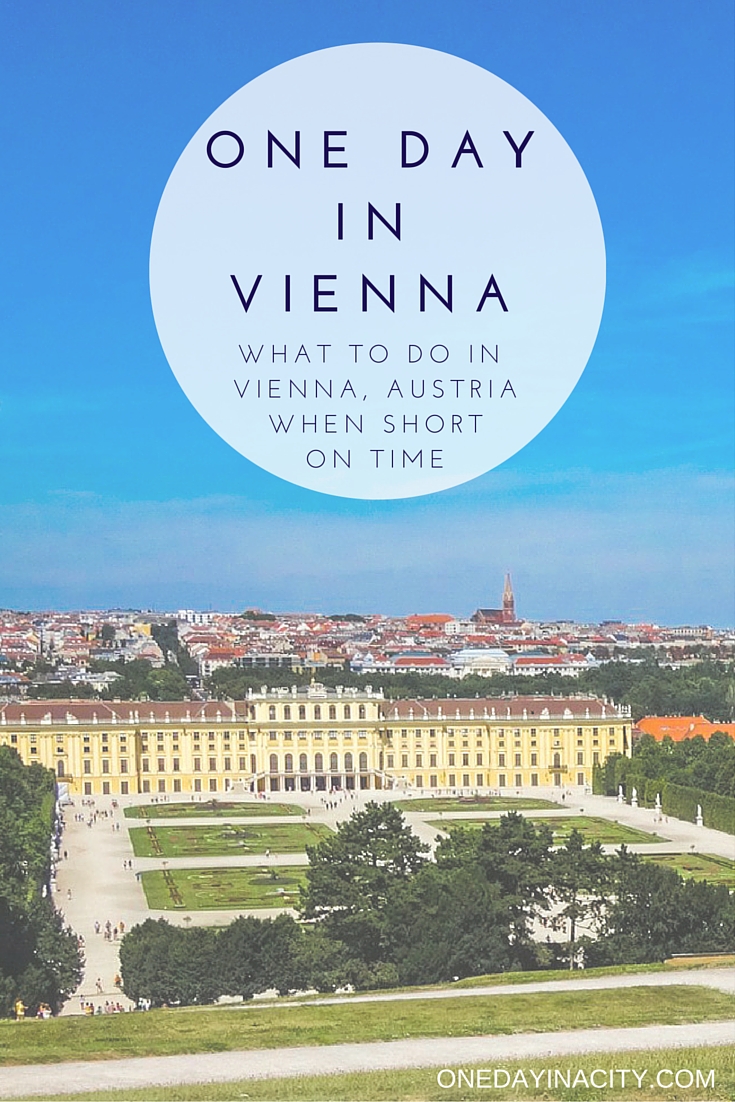
Found this article helpful? Pin it to read again later!
Note: All opening hours, prices, and info was believed to be correct at the time of writing, but is subject to change. Double check all attraction info before leaving for your trip.
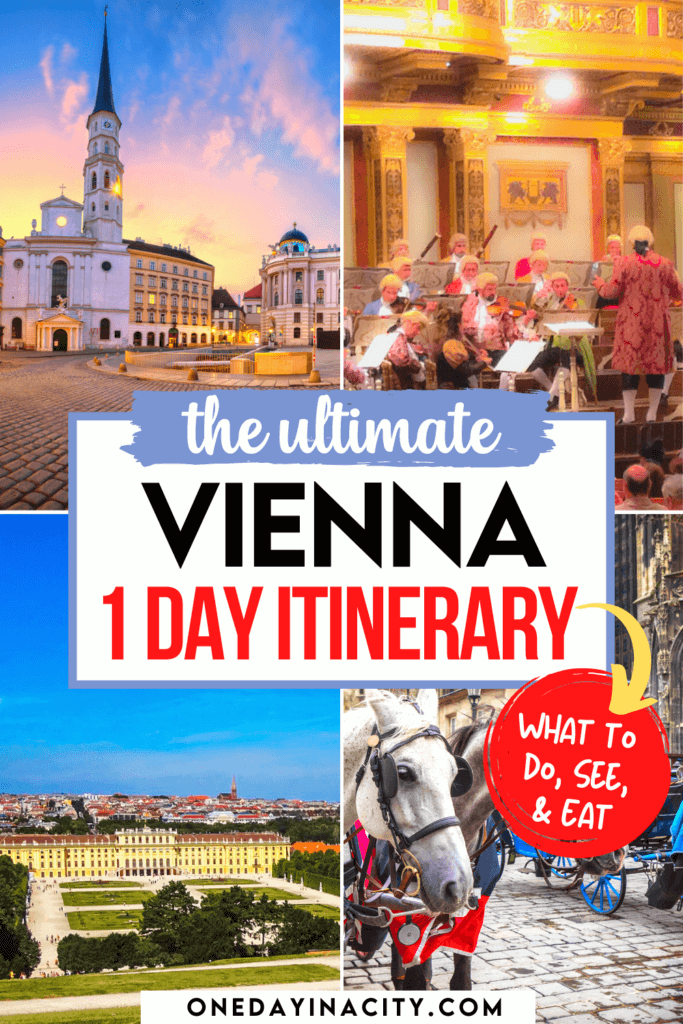
I'm a former travel agency marketing director turned freelance travel writer. My editorial and copywriting work has been published on and in USA TODAY, Travel + Leisure, the Travel Channel Cities app, TripSavvy, and many more online and print publications. I especially love sharing my knowledge of traveling with limited vacation time, making the most of cruise ports of call, and vacationing with kids. I also enjoy sharing my favorite travel gear and products to make traveling easier!
February 2, 2017 at
I’m not personally aware of any to recommend, but Viator.com may offer this type of tour package. Enjoy your layover!
January 26, 2017 at
We (4 people) have a 9 hour layover in Vienna in May 2016. Can you recommend a tour provider that can pick us up at the airport and give us a private tour?
August 12, 2016 at
Yes, that’s correct — the City Airport Train (CAT) takes 16 minutes from the airport to the Wien Mitte stop in the city center.
August 10, 2016 at
How about the train? I read it takes 16 minutes to city center.
August 2, 2016 at
Hello great content and tips for some Wientime, during my summer vacations I will have almost a full day between 2 flights in Vienna. I’m looing for the fastest safest and most reliable transfer from the airport to the city centre and back on time… money is not a problem that much, but of course don’t want the have twice as much as I should… I found this service http://wientransfer.com/ , what do you think of them? Are they good do you anything of them?
Search for a Destination…
- Vienna Travel Planning
- Vienna Notes Newsletter
- Help Centre: Ask a Question
Vienna Unwrapped Inspiration and Planning For Independent Travellers who are visiting Vienna
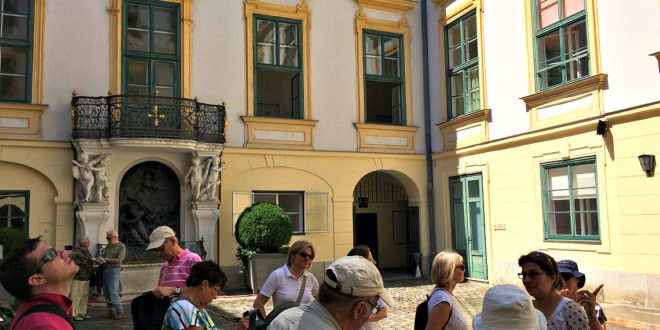
Vienna Tours: Why These 6 Ways Of Exploring Wien Work
- share
- save
- RSS feed
There are dozens of different Vienna tours. Essentially, they help you gain deep insight into how the city ticks, get pointers or just have fun. explore the city in a small group, in private, or in a larger group. To help you do just that I have screened and tested a few tours and guides. Here are 6 proven ways to explore Vienna that work, and another 6 special themed tours to add an extra perspective. Click on each category and tour to learn about what’s on offer.
1. Walking Tours
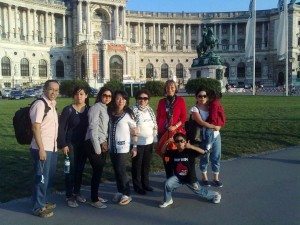
Themed walks allow you to explore Vienna from a special angle, for example Jewish Vienna, Imperial Vienna, or a historic courtyards walk. Most of these Vienna tours include a visit to some of our most beautiful neighbourhoods. Learn more in Vienna Walking Tours .
2. Private Sightseeing
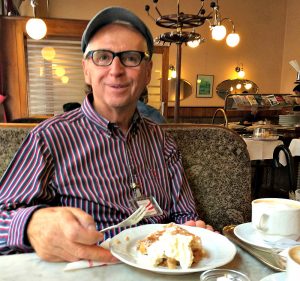
Private tours themselves range from luxurious to down-to-earth. You can tour the city in a luxury limousine with private chauffeur, take themed walks in private or in small groups or to hiking tours in the surroundings. Find out more in Vienna Tours – private sightseeing .
3. Vienna Classical Music Tours
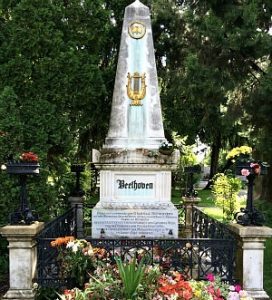
Depending on your interests, you can generally choose between a general music tour, and an in-depth tour including the Central Cemetery.
Since most of these tours are private you will be able to call the shots at all times, and customize your tour: Why not tell your guide to let you pay tribute to Beethoven in Vienna with a special tour? After all, Beethoven lived in Vienna for 35 years, longer than Mozart.
Find out about the best tours on offer in Vienna Classical Music Tours.
4. Tours By Bike
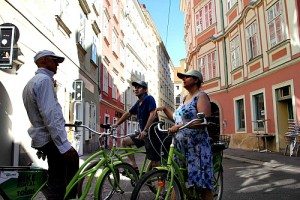
5. Vienna Tours By Segway
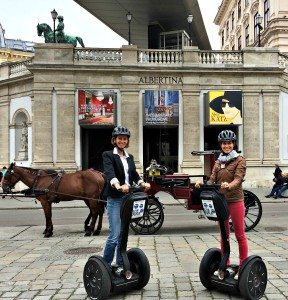
You can choose between booking a Vienna tour with a proper tour guide to see the inner city , going on a nature trail through the woodlands of the Vienna Prater or touring the Danube island . Learn more in my review. Tours By Segway
6. Vienna Tours by Hot Rod
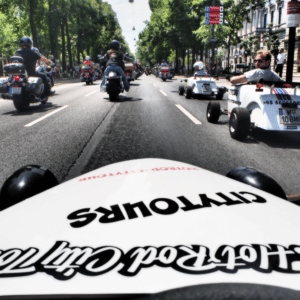
During two hours, you will see all the key sights o Vienna. The cars are easy to drive and you’ll get instructions and safety helmets. Book either a daylight tour or a moonlight tour . (You will get your full money back in case of bad weather.)
Special Vienna Tours
There is a series of special tours through my hometown. I have joined and reviewed a few of them:
1. Private Minivan Tour
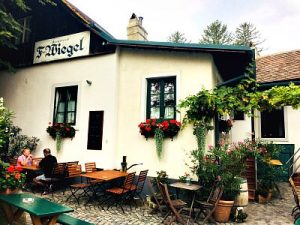
What’s more you will discover sub cultures that hardly any traveller has come across – ever heard of Auf der Schmelz? Find out more in my review of the Vienna Sights Minivan Tour .
2. Vienna Bike Tour
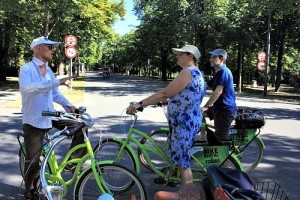
3. Finding The Right Shops In Vienna

Explore how you can find the right shops for you in Vienna in Shopping in Vienna Austria .
4. Otto Wagner Church Tour
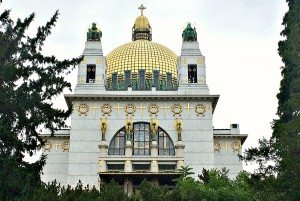
5. Third Man Movie Vienna Tour
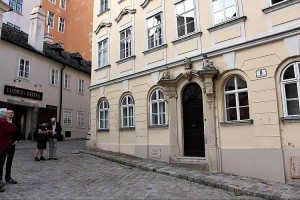
It is also highly informative as you get to know interesting parts of the city centre you probably wouldn’t have visited. Third Man Movie Tour
6. Gasometer City Tour
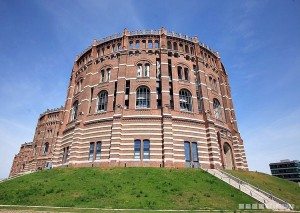
This tour will take you to experience contemporary local architecture and design which transformed four giant 19th-century bricked community gas containers. Gasometer city is also a showcase for contemporary urban living: Vienna’s closest knit community came into existence long before the Gasometers were finished. Gasometer City
Self-Guided Tours
If you want to tour Vienna on your own, the best options are:
- Taking a tour on the Vienna Ringtram . The tramways tour the Ringstrasse with all its state buildings and grand hotels, and are equipped with excellent audio guides and LCD screens.
- Rent a bike with a bike rental firm. There are a few bike rental firms that supply you with tour maps and also deliver the bikes directly to your hotel.
- Rent a Vienna Citybike . The city’s public bike rental scheme has dozens of pick-up and drop-off points in town and is open to visitors.
- Take a simple walk . I have mapped out a few of my favourite Vienna walks that may inspire you.
Need help to coordinate local tours with your Vienna itinerary? Find out more in Vienna Travel Planning – When To Hire A Trip Planner And Travel Consultant
back to Vienna Unwrapped homepage
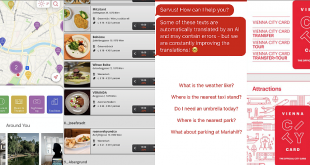
Resources You Need To Plan Your Vienna Vacation
To fast track your planning for a Vienna vacation I have packed a ton of …
Cookies on GOV.UK
We use some essential cookies to make this website work.
We’d like to set additional cookies to understand how you use GOV.UK, remember your settings and improve government services.
We also use cookies set by other sites to help us deliver content from their services.
You have accepted additional cookies. You can change your cookie settings at any time.
You have rejected additional cookies. You can change your cookie settings at any time.
Register to vote Register by 18 June to vote in the General Election on 4 July.
- Business and industry
Travel to Austria for work
Check if you need a visa or permit to work in Austria and how to get one if you do.
This guide is for British citizens travelling for business or other work purposes. It explains what employers, employees, or the self-employed need to do if they need a visa or permit.
This information is provided as a guide only. You must always check the exact application process and document requirements with Austria’s embassy or immigration authorities .
Entry requirements
If you’re going to Austria to work (or any other EU country , Switzerland, Norway, Iceland or Liechtenstein) you must make sure you meet passport and other travel requirements .
Austria is in the Schengen area . If you’re travelling for business for up to 90 days in a 180-day period, you may be able to do some business-related activities without needing a visa or permit, such as attend business meetings. It does not matter how many countries you visit in the Schengen area. Your total stay must be no more than 90 days in every 180 days. The 180-day period keeps ‘rolling’.
If you’re staying for longer, or for other types of work, you may need a visa or permit.
The Austrian authorities are responsible for setting and enforcing entry rules. They decide which activities need a visa or permit, or which may be exempt.
You must always check with the with Austria’s embassy or immigration authorities before you travel, to make sure you meet their legal requirements.
If you’re working in more than one country, you need to check the entry rules of each country.
If you need a passport, visa or permit, you should apply well in advance of travel.
Visa and permit documents
This guide explains the general application process for some of the visa or permit types available in Austria. It includes a checklist of documents that you’ll usually need to include when applying.
It may not cover all scenarios so you must always check the exact application process and document requirements with Austria’s embassy or immigration authorities .
You must also check what format the documents should be presented in, including if they must be:
- translated
- ‘legalised’ (with an apostille) or notarised
- originals, or if copies are acceptable
- signed in ink (a wet signature), or if they can be signed electronically (an e-signature)
- dated within a certain period of time, such as 30 days before you submit your application
Countries often use the terms visa, work permit and residence permit differently. For example, some may refer to a work permit as a visa.
This guide uses the same terms used in Austria, so you know which ones to use when speaking to Austria’s authorities.
Check if you need a visa or permit
You do not need a visa or permit if you’re travelling to Austria for up to 90 days in a 180-day period for specific business-related activities. Each trip must not be longer than 5 working days.
These activities can include:
- running or attending job interviews
- going to court as a witness
- attending trade fairs
- attending board meetings
- meeting clients or customers (including entertainment like eating at a restaurant)
meeting colleagues, contractors or sellers
- fact-finding visits
- negotiating deals or contracts
- attending conferences
- team building activities
- buying goods and services
- accompanying a tour as a tour guide, tour operator or travel agent
- leisure travel, such as holidays or visiting friends or family Or for these types of training, as long as it’s for the same company or group:
- classroom-based training
- on-the-job training
Attending business meetings
You should only attend business meetings if there isn’t a colleague in Austria who can do this on your behalf. If you have to attend you:
- shouldn’t stay longer than a working week
- cannot charge the client for the meeting
These activities are usually allowed while travelling under the Schengen visa waiver .
Border checks
At the border, you may be asked to show:
- proof of return travel, such as plane or train tickets
- health insurance that covers your entire stay
- proof of accommodation for your entire stay
- enough money for the duration of your trip
Check Austria’s exemptions
Certain types of work-related activities don’t require a visa or permit because they’re exempt.
All countries have their own exemptions. What may be exempt in one country may not be in another. You should always check with the country’s authorities.
You do not require a visa or permit if you’re a musician, performer or broadcaster and in Austria for up to 4 weeks.
This includes those involved in film, TV or radio, including the technical production team. Find out more about short-term artistic activity .
The organiser needs to notify the local public employment service no later than the first day of work in Austria.
EU intra-company transfer permits (EU ICT) from other countries
You don’t need a visa or permit if you have an EU intra-company transfer (EU ICT) from another country and you’re going to work for the Austrian branch for up to 90 days in a 180-day period.
Your employer has to notify the Zentrale Koordinationsstelle (ZKO) of the Federal Ministry of Finance before you travel.
Exemptions are covered by the Schengen visa waiver .
Show proof of exemption
You need to be able to show proof that you’re exempt to the authorities on request. This could be:
- an assignment letter
- employment confirmation
- a contract
- proof of required qualifications, such as a diploma or professional certificate, or proof of artistic activities
If you’re going for other work purposes for up to 3 to 6 months, you may need a short-term work permit.
If you’re going for longer than 6 months days you may need a long-term permit.
Further checks
If you’re not sure if you need a visa or permit to travel you can get advice from Austria’s embassy or immigration authorities .
Applying for a visa or permit
This guide outlines the steps required for each visa or permit to help you prepare, but you’ll need to check the exact rules and processes with Austria’s embassy or immigration authorities .
Taking your family
For the short-term visa and permits listed in this guide your family will not be able to get dependant visas. They may be able to join you for up to 90 days under the Schengen visa waiver .
There may be different rules for taking families if you have a long-term permit. Find out about family reunification .
Short and long-term visa and permits
You need a short-term visa or posting permit (Beschäftigungsbewilligung/Entsendebewilligung) if you’re providing short-term services to a client in Austria.
You need to apply for one of these permit types:
- posting permit if your UK employer has a contract or work order with an Austrian company
- highly skilled key workers permit
- short-term freelancer visa
You need to apply for a long-term residence and work permit if you’re working in Austria because you’re:
- transferring long term from a UK-based company to a branch in Austria
- working for an Austrian company on a long-term Austrian contract
- providing long-term services to a client in Austria
- carrying out long-term self-employed work
- a founder of a start-up company in Austria
- conducting research work
- working long term as an artist
They are valid for up to 2 years and you can extend them.
Short-term posting permit
You need a posting permit if your UK employer has a contract or work order with an Austrian company for up to 6 months.
To qualify for a posting permit you must:
- be paid a salary at an equivalent level to a similar position in Austria
- have relevant professional experience or a university degree
- keep your UK employment contract
- stay on UK payroll
It takes 4 to 10 weeks to get. It’s valid for up to 4 months and you can extend it.
How it works
You need to check with Austria’s authorities on the exact process. This is a rough guide to help you prepare.
The Austrian client applies for your posting permit at the Public Employment Service (AMS) .
You apply for a C or D visa at the Austrian embassy. You apply for a C visa: Erwerb (Schengen visa) if you’re working for up to 90 days in a 180-day period. You apply for a D visa: Erwerb if you’re working for up to 4 months.
You register your address with your local city hall in Austria within 3 business days of arriving.
Application documents
Austria’s authorities may request different documents at different stages of the process. Usually, they need:
- completed permit application form
- UK passport, valid for 3 months (6 recommended) from the date you intend to leave Austria
- degree or other qualification certificate (if you have one)
- employment contract or confirmation from your UK employer
- assignment agreement with the Austrian company
contract or work order between your UK employer and the Austrian company
- health insurance covering your stay in Austria or a social security waiver certificate
- registration form signed by your landlord in Austria (required after arrival in Austria)
Short-term highly skilled key worker permit
If your UK employer provides a contractual service to an Austrian end user you may be able to get a highly skilled key worker permit.
To qualify you must:
- be working in a profession listed in annex serving 4 of the Trade and Cooperation Agreement , which includes accountants and tax advisers
- have a university degree or equivalent qualification
- have at least 3 years’ professional experience
- have worked with your employer in the UK for at least 12 months
- keep your employment in the UK
You must not get paid in Austria.
It’s valid for up to 6 months in a 12-month period or for the duration of the contract, whichever is shorter.
The Austrian client applies for your posting permit or work permit at the Public Employment Service (AMS) .
You apply for a C or D visa at the Austrian embassy. You apply for a C visa: Erwerb (Schengen visa) if you’re working for up to 90 days in a 180-day period. You apply for a D visa: Erwerb if you’re working for up to 6 months.
It’s not yet clear how long it takes to get as it’s a new permit type and the exact details are still being confirmed by the Austrian authorities.
Make sure you apply well in advance of travel.
Short-term freelancer visa
If you’re a UK-based freelancer and want to work in Austria, you can apply for a short-term freelancer visa.
- be based in the UK and not be established in the EU
- be providing a service listed in annex servin 4 of the Trade and Cooperation Agreement , which includes research and development services, market research and telecommunications
- have a degree or equivalent qualifications
- have professional qualifications required for your trade
- have at least 6 years’ relevant professional experience
You apply for a C or D visa at the Austrian embassy. You apply for a C visa: Erwerb (Schengen visa) if you’re working for up to 90 days in a 180-day period. You apply for a D visa: Erwerb if you’re working for up to 6 months.
It’s not yet clear how long it takes to get as it’s a new permit category and the exact details are still being confirmed by the Austrian authorities.
Transferring long term from a UK-based company to a branch in Austria
You need an ICT residence permit if your UK-based employer moves you to a branch in Austria to work for:
- up to 3 years (with an extension), if you’re a manager or specialist
- 1 year, if you’re a trainee
- be a manager, specialist or trainee
- have worked for the UK company for at least 12 months, or 6 months if you’re a trainee
- earn a salary that’s in line with Austrian requirements for the position (collective bargaining agreement)
- have a bachelor’s level degree or proof of relevant experience
It takes 8 to 12 weeks to get. The permit is granted for 1 year. If you’re a manager or specialist you can extend it to 3 years.
If you have a family, they can join you as dependants with this permit type. Check with Austria’s authorities on the exact process.
You complete a residence permit application using the related guidance ‘ Aufenthaltsbewilligung – ICT (12) ’ or ‘ Aufenthaltsbewilligung – mobile ICT (13) ’ and submit it to the Austrian embassy.
You collect your ICT permit from the local immigration office.
- UK passport for you and any dependants valid for 3 months (6 recommended) after you intend to leave Austria
- degree or other qualification certificate
- employment declaration signed by the Austrian company
- organisational charts or documents showing the relationship between your UK employer and the host company in Austria
- birth certificate for you and any dependants ( ‘legalised’ with an apostille )
- marriage certificate ( ‘legalised’ with an apostille )
- police clearance certificate valid for 3 months from the date of applying ( ‘legalised’ with an apostille )
- proof of accommodation in Austria, such as a hotel reservation
- registration form signed by your landlord in Austria (required after arriving in Austria)
- proof of enough money to support yourself, such as bank statements, contracts, payslips for the past 3 months
- a 45 x 35mm photo taken within 6 months of applying
Working for an Austrian company on a long-term Austrian contract
If you have an offer of employment with a company in Austria, you need to apply for one of these permit types:
- a Red-White-Red Card – a points-based residence permit
- an EU Blue Card – for highly skilled work in Austria for at least a year
Red-White-Red Card
The Red-White-Red Card (RWR) has a points-based system which takes into account factors such as your:
- level of education
- work experience
Each factor is given points. You need a certain number of points depending on the type of work you’re doing.
Points required for:
- highly qualified workers – minimum 70 points
- skilled workers in a shortage occupation – minimum 55 points
- other key workers – minimum 55 points
- graduates of a university or college of higher education in Austria – no points required
If you’re highly qualified, a skilled worker in a shortage occupation, or a key worker you must:
- have a bachelor’s level or vocational degree, be eligible for admission to university or have proof of relevant work experience
- have an offer of employment with a company in Austria
- be placed on Austria’s payroll
If you’re a key worker check how much you need to be earning to qualify .
Your salary must be paid in 14 monthly instalments a year (Austria makes 2 payments in 2 of the months).
Your Austrian employer will need to complete a labour market test.
Self-employed workers and start-up founders can also apply for this permit.
It takes 8 to 12 weeks to get a Red-White-Red Card. It’s valid for up to 2 years and you can extend it.
The Red-White-Red card can only be issued until the validity of your passport. This permit type could lead to permanent residence after 5 years if you meet the criteria.
If you have a family, they can join you as dependants with this permit type. Find out about family reunification .
You complete a residence permit application using the related guidance ‘ Rot-Weiß-Rot – Karte (1) ’ and submit it to the Austrian embassy.
You collect your RWR Card.
- signed employment contract with an Austrian employer
- employer declaration stating your salary signed by the Austrian employer
- health insurance covering your stay in Austria
EU Blue Card
To qualify for an EU Blue Card residence permit you must:
- have at least 3 years’ education at bachelor’s degree level
- have an offer of employment from an Austrian company for at least six months in a related sector to your degree subject
- meet gross annual salary requirements
Your employer must complete a labour market test to make sure you’re not taking work that could be carried out by a jobseeker in Austria who is equally qualified for the role.
It takes 8 to 12 weeks to get. It’s valid for up to 2 years and you can extend it. It could lead to permanent residence if you meet the criteria.
You complete a residence permit application using the related guidance ‘ Blaue Karte EU (3) ’ and submit it to the Austrian embassy.
You collect your EU Blue Card from the local immigration office.
- proof you have enough money to support yourself, such as bank statements, contracts, payslips for the previous 3 months
Providing long term services to a client in Austria
You can apply for a work permit to provide services (Beschäftigungsbewilligung) if your UK employer has a service agreement with an Austrian company.
- have relevant professional experience or university degree
- be paid a salary that is equivalent to the Austrian standard salary for a similar position
It takes 8 to 12 weeks to get. It allows you to work for more than 4 months up to 1 year and you can extend it.
You will not be able to get dependant visas for any family members if you have a work permit to provide services. They may be able to join you for up to 90 days under the Schengen visa waiver or if they have their own permit.
The Austrian client submits your work permit application to the Public Employment Service (AMS) .
You apply for a D visa: Erwerb if you’re staying for up to 6 months. If you’re working for more than 6 months you’ll need to apply for a residence permit at the Austrian embassy. This is in addition to the permit your employer applies for.
You collect your residence permit card if you’re staying for more than 6 months.
- UK passport valid for 3 months (6 recommended) after you intend to leave Austria
- UK employment contract
Self-employed work
You can apply for a Red-White-Red (RWR) Card as a self-employed key worker if your self-employed occupation is economically beneficial to Austria.
There are no point requirements.
- intend to make a substantial financial investment in Austria
- create new jobs or secure existing jobs in Austria
- work in an occupation that is of considerable importance for a region of Austria
It takes 8 to 12 weeks to get. It’s valid for up to 2 years and you can extend it. This permit could lead to permanent residence if you meet the criteria.
If you have a family they can join you as dependants with this permit type. Find out about family reunification .
Your application will be forwarded to the Public Employment Service (AMS) who will evaluate whether your work is economically beneficial to Austria.
You collect your Red-White-Red Card from the local immigration office.
Austria’s authorities may request different documents at different stages of the process.
Usually, they need to see documents that relate to the economic benefits of your work, such as:
- business plans
- evidence of transfer of investment capital and intention to create new jobs or secure existing ones
- professional qualification certificates
They will also need to see:
- UK passport for you and any dependants valid for 3 months after your intended return date
- diploma or other qualification certificate
- proof of sufficient financial means to support yourself, such as bank statements, contracts, payslips or investment capital
Start-up founders
Founders of a start-up in Austria can apply for a Red-White-Red Card .
- establish a company for ‘innovative products, services, processing methods or technologies’
- create a detailed business plan
- have a controlling influence on the management board of the company
- meet capital and equity requirements
- score at least 50 points
To extend it you must go through another examination process with the Public Employment Service (AMS) .
- business plan detailing your innovative business idea
- evidence of special skills, such as testimonials and certificates
- evidence of investment capital
- evidence that you have controlling influence on the company (at least 50% equity share)
- evidence of funding for start-up companies in Austria or admission to a business incubator
- language certificates for English or German
- proof of sufficient financial means to support yourself, such as bank statements, contracts, payslips for the past 3 months
Research work
You can apply for a settlement permit for research if you work for a recognised research institution.
It takes 8 to 12 weeks to get. It’s valid for 2 years and you can renew it. This permit could lead to permanent residence if you meet the criteria.
You complete a residence permit application using the related guidance ‘ Niederlassungsbewilligung – Forscher (11) ’ and submit it to the Austrian embassy.
You collect your permit from the local immigration office.
- hosting agreement with a research institution
Working as an artist
If you want to work in Austria as an employed or self-employed artist you can apply for a settlement permit for artists .
You need to provide one of the following:
- a declaration from your employer confirming that you will comply with the conditions of your employment
- a contract for self-employed work for a minimum of 6 months
It takes 8 to 12 weeks to get. It’s valid for 1 year and can be renewed. This permit could lead to permanent residence if you meet the criteria.
You complete a residence permit application using the related guidance ‘ Niederlassungsbewilligung – Künstler (9) ’ and submit it to the Austrian embassy
You register your address with the local city hall in Austria within 3 business days of arriving.
You collect your work and residence permit card from the local immigration office.
- proof of artistic qualifications or description of previous work
- employer declaration in line with the ‘Ausländerbeschäftigungsgesetz’ for employed artists
- contract for self-employed work for a minimum of 6 months
- language certificates for German
Austrian government guidance
Read official Austrian government information on visas, work permits, and residence permits .
Check for business travel changes
European governments may update or change their rules without notice.
You should always check general travel advice for Austria for updates on issues, such as safety and security, entry requirements and travel warnings before travelling, or planning to travel.
Additional information on the description and application documents for the Red-White-Red card and EU Blue Card.
Content reviewed. No changes made. (The information provided is up-to-date as of 11 September 2023.)
Content reviewed. No changes made. (The information provided is up-to-date as of 21 July 2023).
There is a new application form for the following permits: EU Blue Card, ICT residence permit, Red-White-Red Card, settlement permit for research and settlement permit for artists. (The information provided is up-to-date as of 22 March 2023).
Content reviewed. No changes made. (The information provided is up-to-date as of 9 January 2023).
Updated the section 'Check if you need a visa or permit'. If you're doing travelling for of the business-related activities listed here, each trip must be no longer than 5 working days. The information provided is up-to-date as of 23 September 2022.
You'll no longer be asked to show an invitation letter explaining your trip at border checks. The information provided is up-to-date as of 30 November 2021.
Added information on how to apply for the new 'Short-term highly skilled key worker permit' and 'Short-term freelancer visa'.
First published.
Related content
Is this page useful.
- Yes this page is useful
- No this page is not useful
Help us improve GOV.UK
Don’t include personal or financial information like your National Insurance number or credit card details.
To help us improve GOV.UK, we’d like to know more about your visit today. Please fill in this survey (opens in a new tab) .
Flights to Vienna
Centuries of imperial and artistic tradition give Vienna its distinctive character, with Baroque architecture lining streets that were home to some of the world’s most famous composers and artists. Countless parks and gardens are nestled among the grand buildings, and the city is flanked by rolling green vineyards and romantic viewpoints.
Our cheapest flights to Vienna
Flights from
Visit the home of the waltz
Fly to Vienna with British Airways and walk in the footsteps of Beethoven, Freud and the ‘Waltz King’ Johann Strauss II.
Start your sightseeing with the iconic Schönbrunn Palace, former summer residence of the Habsburgs and now a UNESCO World Cultural Heritage Site.
Then stroll over to the MuseumsQuartier, one of the largest cultural quarters in the world, and enjoy its many museums, galleries and restaurants.
Spend the evening embracing Vienna’s diverse musical scene, soaking up the sounds of an orchestra, opera or nightclub. Book your holiday to Vienna today.
Flight time
2 hrs 15 mins
Vienna flight FAQs
It takes two hours and 30 minutes to fly to Vienna from London.
The Christmas markets and glamorous balls attract lots of visitors to Vienna in winter, while summer draws crowds admiring the imperial architecture. If you're looking for a bargain, try searching for flights outside of these peak times. Use our low fare finder to find the cheapest time to fly to Vienna.
We fly direct to Vienna from London Heathrow airport (LHR). The number of flights departing each week and flight times vary by airport.
There are plenty of ways to make your money go further in Vienna. Schemes like the Vienna PASS and Vienna City Card give you free or discounted access to major attractions and public transport. Or, you could time your visit to coincide with the first Sunday of the month, when several top museums offer free entry. To keep travel costs down, you can explore this compact city on foot or take advantage of the low-cost bike hire schemes. You could even pick up cheap tickets to the world-famous Vienna operas if you don't mind a restricted view or queuing for last-minute standing tickets.
Vienna has a great public transport network and Vienna International Airport is within easy reach of the city centre by train, bus, taxi or transfer. The City Airport Train is the fastest link, taking just 16 minutes to whisk you into the heart of the city. Buses can take as little as 20 minutes and run 24 hours a day.
If you're planning to visit Vienna's surrounding wine regions or explore more of Austria, hire a car with British Airways. You'll receive great benefits, with all mandatory charges included and 24-hour customer support, plus you'll collect Avios points on every rental.
The Austrian capital has been a cultural hotspot for hundreds of years. You can spend hours marvelling at the elegant palaces, opera houses and ballrooms. Plus, more than 100 museums house world-class treasures for you to discover, covering topics as diverse as Austrian history, modern art and optical illusions. Once you've seen it all from ground level, get a different perspective by enjoying the view from the rides at the Prater Amusement Park, including the historic giant Ferris wheel. When all the excitement gets too much, sit back and soak up the traditional Viennese coffeehouse culture.
You can book a hand baggage-only ticket or make the most of our generous baggage allowance. If you choose economy standard or one of our British Airways Holidays’ packages, each passenger can check in a bag weighing up to 23kg – in addition to a handbag, laptop case or other small bag. Families travelling in any cabin with younger children can also check in one car seat and one fully collapsible pushchair. Read more about baggage allowances for children .
If you’re flying in our business cabin, you can check in two bags weighing up to 32kg each. Read our baggage guide for full details.
Citizens of the UK and Ireland and EU passport holders do not need a visa to visit. If you hold a passport from a country or territory outside of these areas, you may need to apply for a visa before you travel. You can find out more about visa requirements for all the countries we fly to at the IATA Travel Centre .
Discover outstanding service from the moment you book. Choose to fly with hand baggage only or pick a price that includes a 23kg checked baggage allowance and free seat selection 24 hours before you fly. On board you'll find HEPA-filtered air, quality on-board catering and a warm, uniquely British welcome.
Simply relax and let us take care of you, every step of the way.
All our cabins offer the same great – and uniquely British – experience. Choose your perfect way to fly, from economy to business.
Our Euro Traveller cabin offers all the touches you need to enjoy your flight at an affordable price.
Work or relax in our Club Europe cabin and enjoy lounge access, a dedicated check-in area and more personal space.
Discover more of Europe...
Budapest flights, innsbruck flights, krakow flights, prague flights, salzburg flights, warsaw flights, terms and conditions.
- Flight only prices are updated every 24 hours and are accurate when published. Flights at these prices are limited and may sell out quickly.
- Package holiday prices (flight + hotel or flight + car) prices are updated every 24 to 48 hours and are accurate when published and may vary upon reaching subsequent pages. Availability may be extremely limited particularly during peak periods.
- Return fares displayed are the lowest adult return prices in the cabin specified including taxes, fees and carrier charges, based on a 7-day return journey.
- Each–way fares displayed are the lowest adult each-way prices in the cabin specified based on the lowest adult return prices for a 7 day travel period, including all taxes, fees and carrier charges available in this period.
- One-way fares displayed are the lowest adult prices in the cabin specified including taxes, fees and carrier charges available in this period.
- Package holiday prices (flight + hotel and flight + car) shown are in GBP per person based on 2 adults sharing one room or one car and prices include taxes, fees and carrier charges unless otherwise specified. Flight + car prices based on drivers aged 30-70 years.
- Additional charges will be applied for payments made using a corporate credit card.
- Advertised fares are available on ba.com. Additional charges may apply if purchased through British Airways outlets or travel agents.
- Combine and save on Holidays: Guaranteed savings are only available when booking a Flight + Hotel or Flight + Car booking including one land product, it does not apply to a ‘Customise your trip’ holiday including more than one hotel and / or car.
- Package holidays are protected under British Airways Holidays Ltd by the Civil Aviation Authority. Our ATOL number is 5985.
- Standard British Airways terms and conditions apply

IMAGES
VIDEO
COMMENTS
Travel and work in Vienna, Austria. Learn new skills and travel on a budget doing a work exchange with Worldpackers.
Guide to backpacker jobs in Austria by season. Volunteer & work visa info. Work and travel using your skills to build references for a job back home.
Stays abroad for professionals. "Erasmus for professionals" is that even possible? With Work Exchange it is! We offer programs abroad for qualified professionals, including all necessary amenities, remote working set-ups and a global group of friends & peers. Check out our first program location in Vienna and experience the time of your life!
Buche deinen flexiblen Work and Travel Aufenthalt mit AIFS in deinem Traumland und verbinde Arbeit und Abenteuer mit Urlaub und Freiheit. Hier informieren!
Work and Travel Österreich, das ist Jobben im Bereich Wintersport, in der Gastronomie bzw. in Hotels, Au-pair oder ein Auslandspraktikum.
We're a laid-back, cozy hostel in Vienna, Austria. We've been around since 1968 and we are currently the best rated hostel in the city! ... Work and travel in Austria Work and travel in Europe Hostel Austria Last minute Work and travel in Austria. Help our international family with some DIY projects in Hörbranz, Austria. Experience and enjoy ...
TravelWorks ermöglicht Dein Auslandsabenteuer: Work and Travel, Freiwilligenarbeit, Sprachreisen, English Adventure Camps, Sprachferien & Schüleraustausch!
Want an opportunity to work as a volunteer or exchange your skills for accommodation in Austria? At Worldpackers you can find the best countries to live and learn in!
The phrase Work and Travel is not only work, but also an internship in Austria for students. During your free time from work or on weekends, travel around Austria or travel to neighboring countries. ... Vienna, Innsbruck, Salzburg, Graz, as well as throughout the whole country. How long can students work in Austria? Students can work up to 40 ...
Combining work and travel is my ideal work environment. Stephansdom in Vienna, Austria PHOTO: Erin Porter I am still getting to know the magnificent city known as Wien , but here are my recommendations on where to visit in Vienna, Austria .
Working Holiday Programmes (WHP) were set up to meet the relevant demands and enable young people between 18 and 30 to finance their (holiday) stay abroad - at least to some extent - themselves, gather practical vocational experience in another country and benefit from the local educational facilities.
Volunteer in Austria - Join now the world's leading community for volunteering, working and cultural exchange.
To work in Austria through a bilateral Youth Mobility program, you must: be a Canadian citizen. be 18-30 years old (inclusive) for the Working Holiday Programme, or. be 18-35 years old (inclusive) for the Intra- and Partner-Company Training Program or the Young Workers Exchange Program, and. have a Canadian passport that's valid for at least ...
International experts for Austria jobs in Austria upcoming events immigration guide Austria living & working guide Austria. » Learn more here!
Temporary stay with residence permit ICT & Mobile ICT Seconded Employee Self-employed Student Pupil Social worker and more » All information here!
The majority of expats relocate to Vienna as a result of a transfer from within their company. That said, there are a number of strong industries in Vienna, and highly skilled expats may find they have the expertise to fill a gap in the local workforce. Expats who are citizens of EU-member states can legally work in Austria without any special ...
International Students From Education to Career We are happy to assist you as a graduate in pursuing your career in Austria and support you free of charge on your transition from your studies to entering the Austrian labour market.
Jobs in Vienna, Austria. Vienna, Austria's capital and the sixth largest city in the European Union, perennially ranks as one of the most prosperous cities in the world where to find work abroad. Known as the City of Music because of its rich classical legacy, Vienna has for many centuries been one of the most important cultural hubs on the ...
Working Holiday in Germany: all you need to know about the Working Holiday Visa, Work & Travel jobs and insurance in Germany.
Want an opportunity to work as a volunteer or exchange your skills for accommodation in Vienna, Austria? At Worldpackers you can find the best countries to live and learn in!
Short on time in Vienna? This super detailed and helpful 1-day itinerary has the top things to do plus how to experience the culture of Vienna in just one day.
Find out EXACTLY why these 6 kinds of Vienna tours work to explore home town Vienna Austria, work. And what to expect from these 6 themed...
Check if you need a visa or permit to work in Austria and how to get one if you do.
Our Vienna flights (VIE) include a generous baggage allowance, award winning service and more. ... To keep travel costs down, you can explore this compact city on foot or take advantage of the low-cost bike hire schemes. ... Work or relax in our Club Europe cabin and enjoy lounge access, a dedicated check-in area and more personal space.